
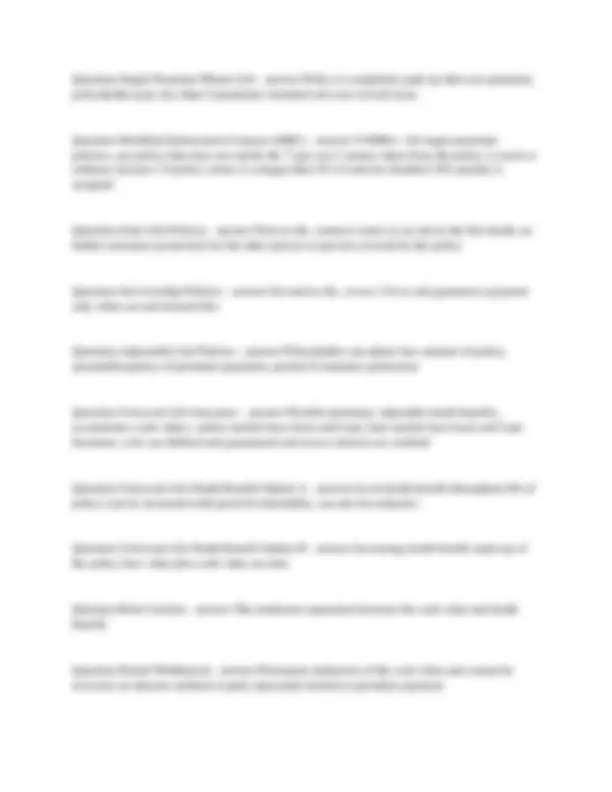

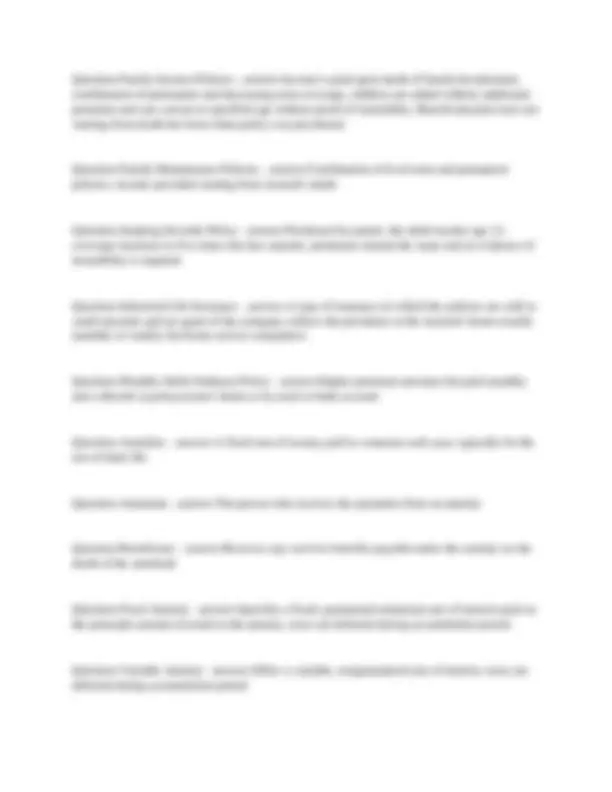
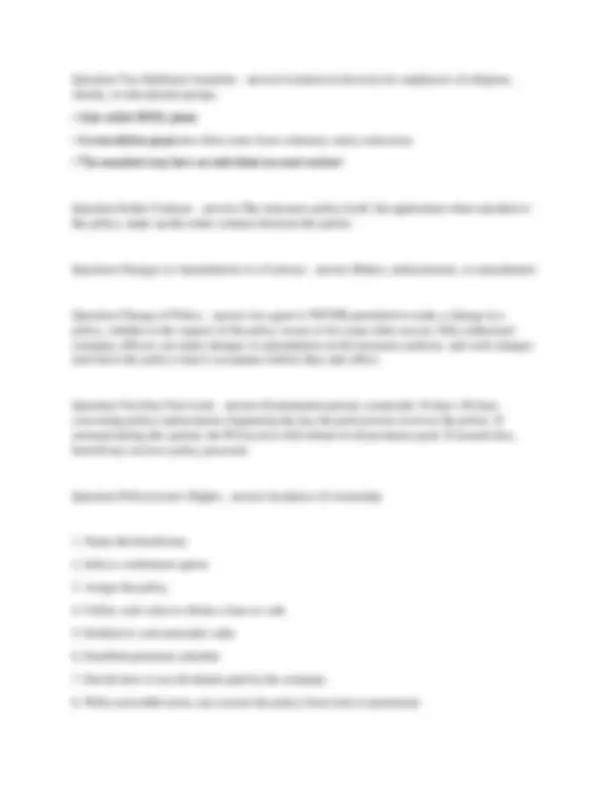
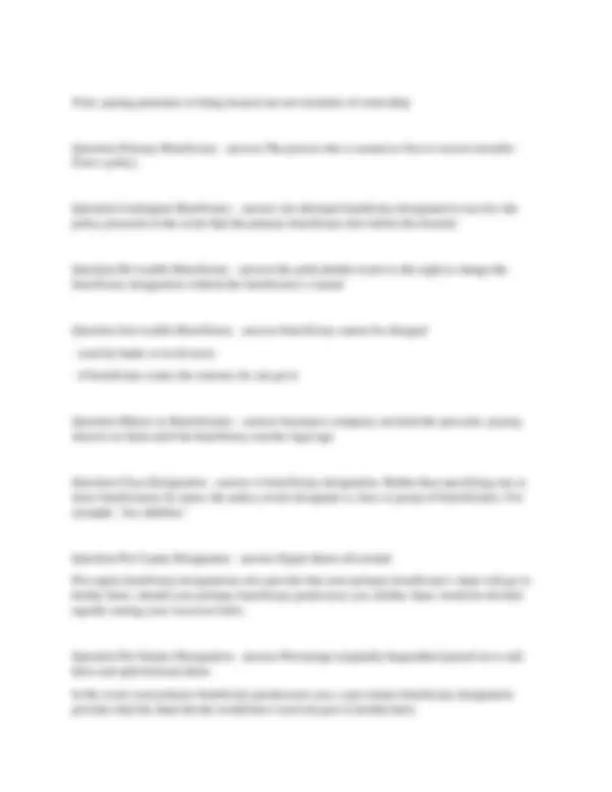
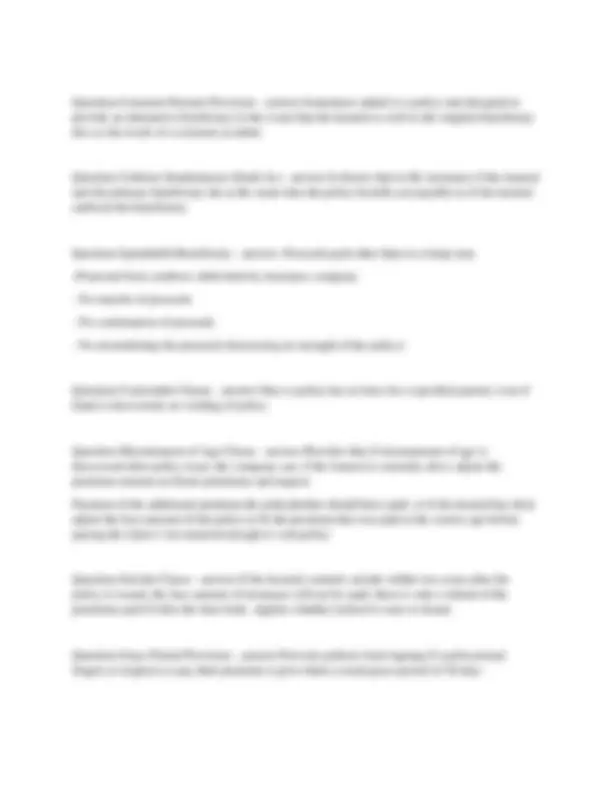
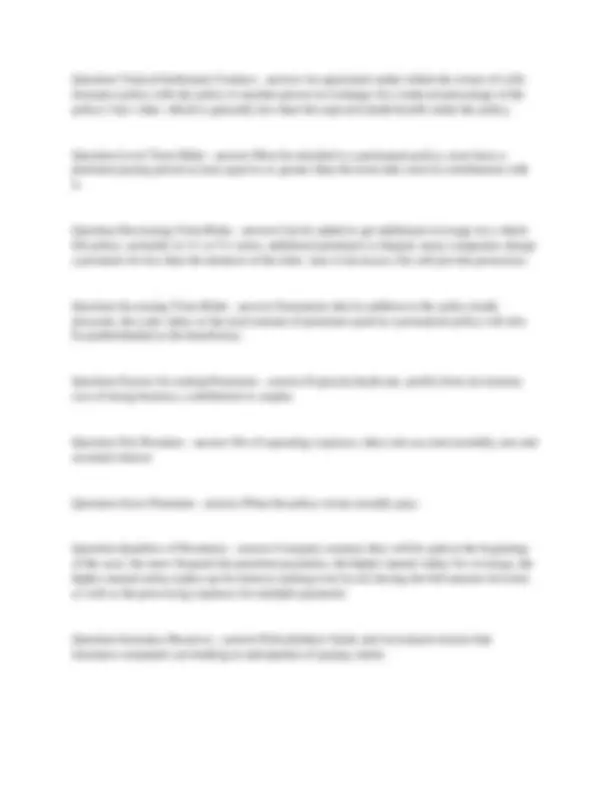
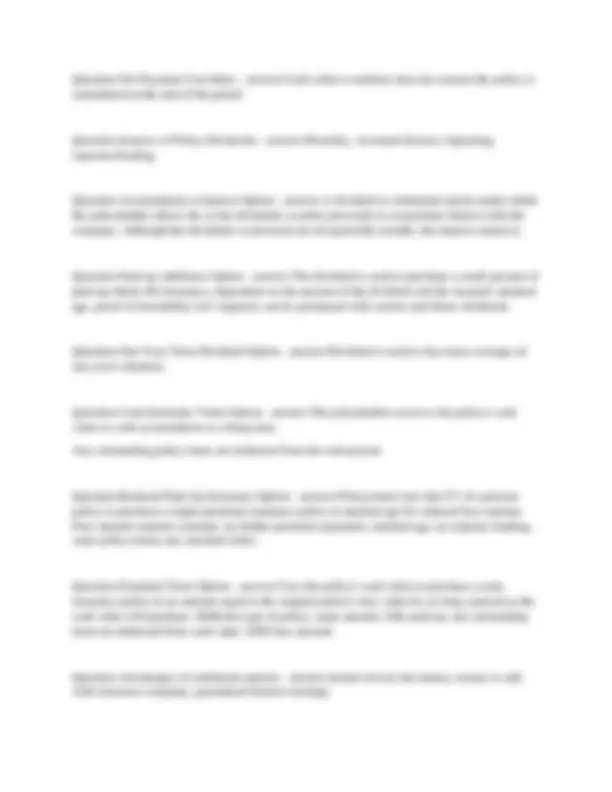
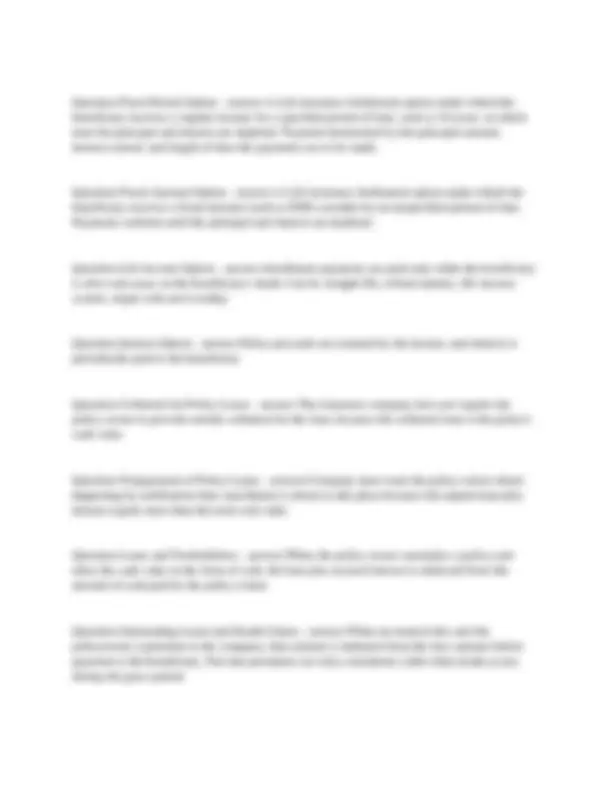
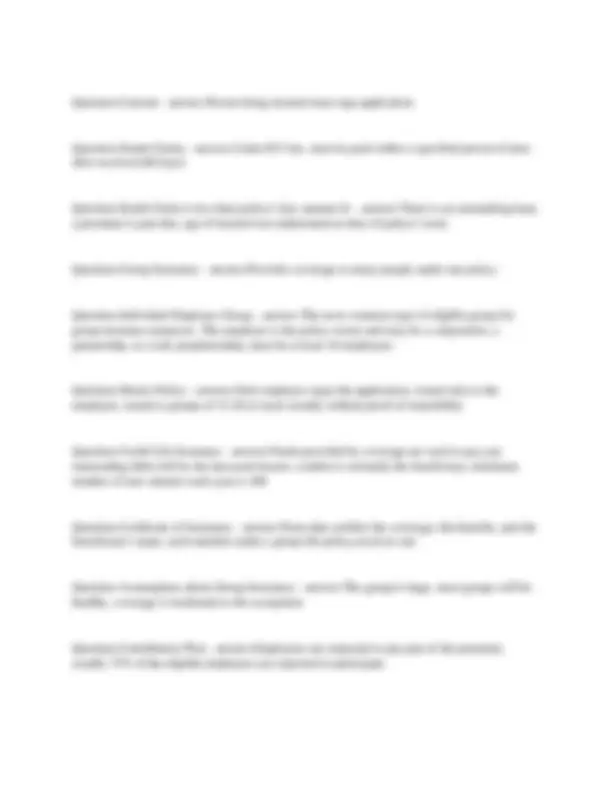
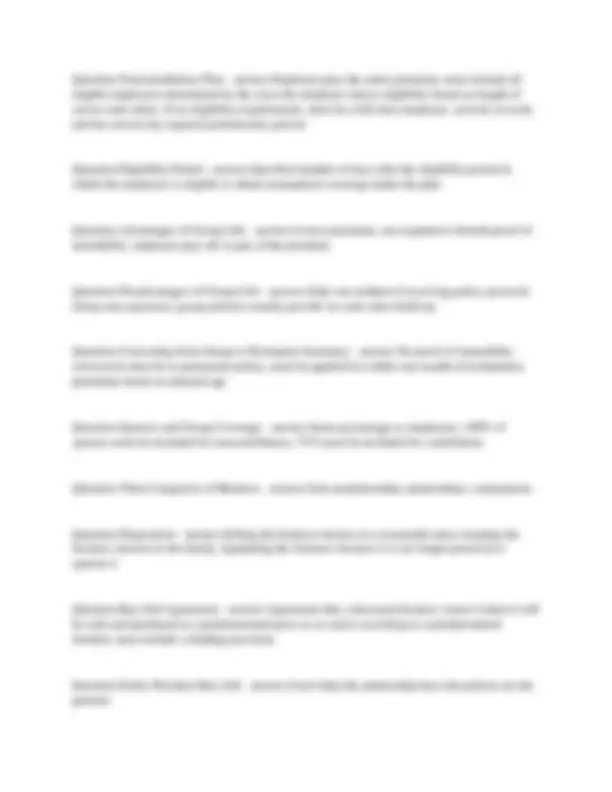
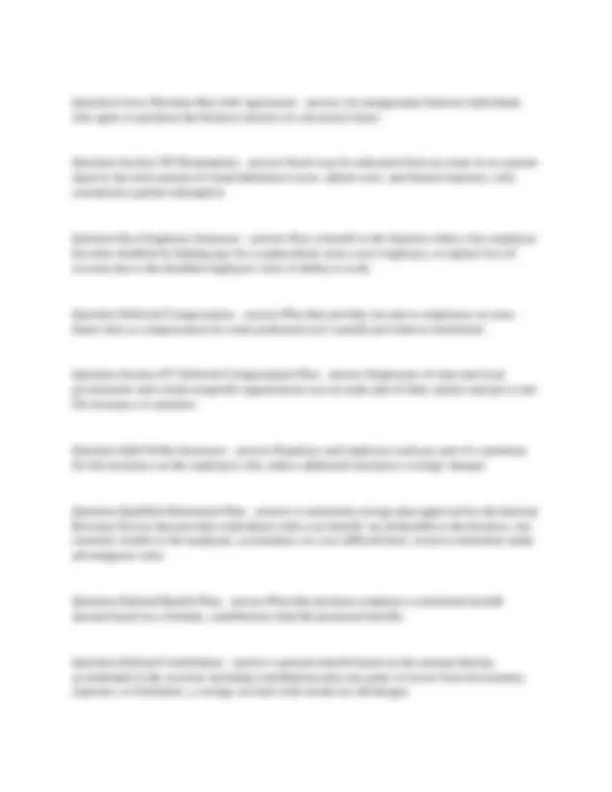
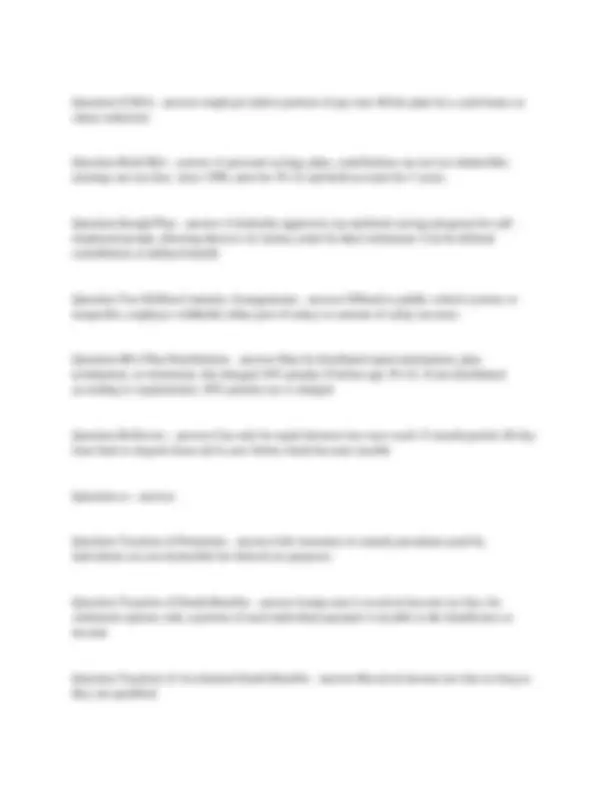
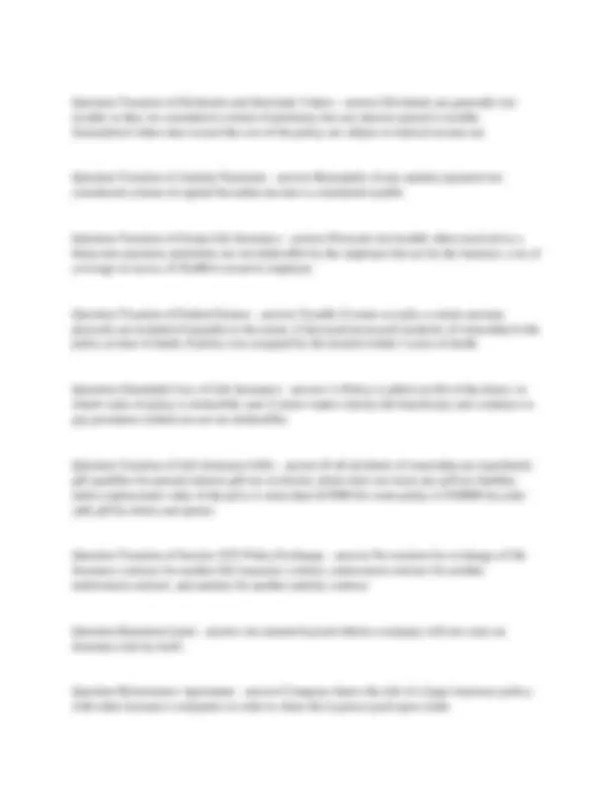
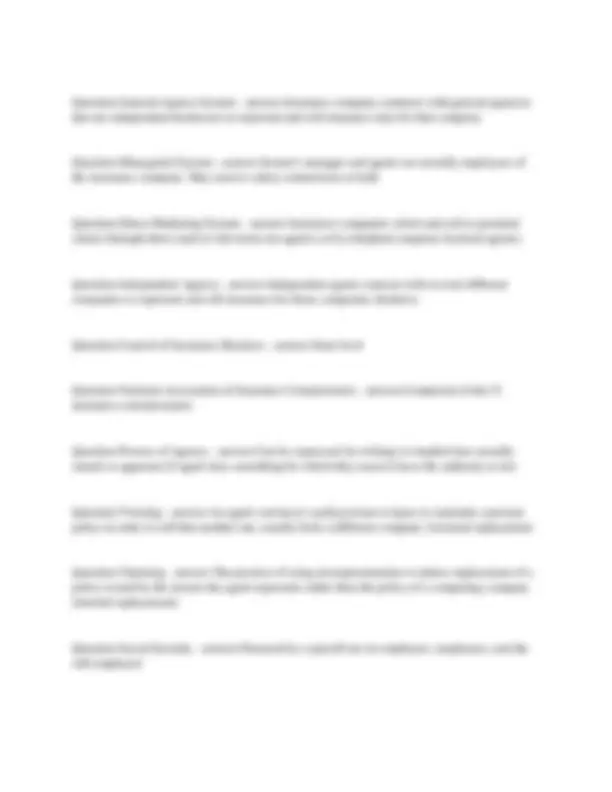
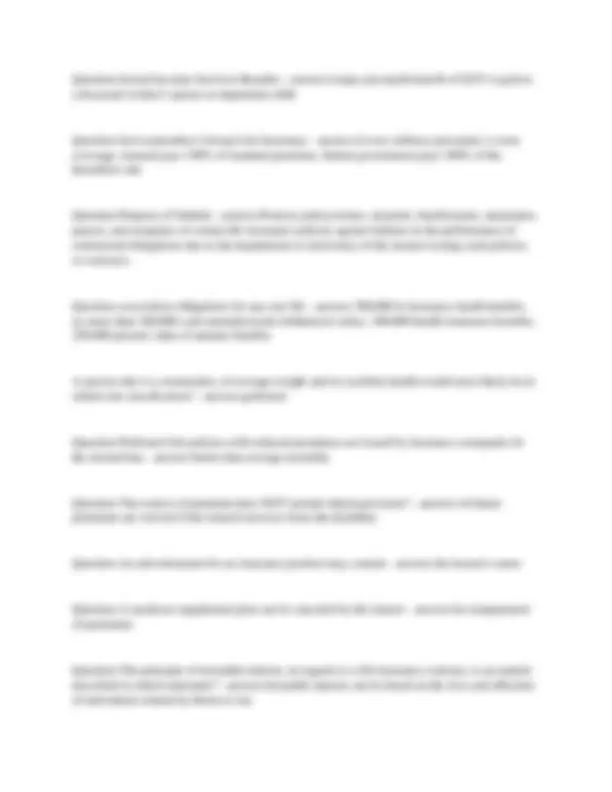
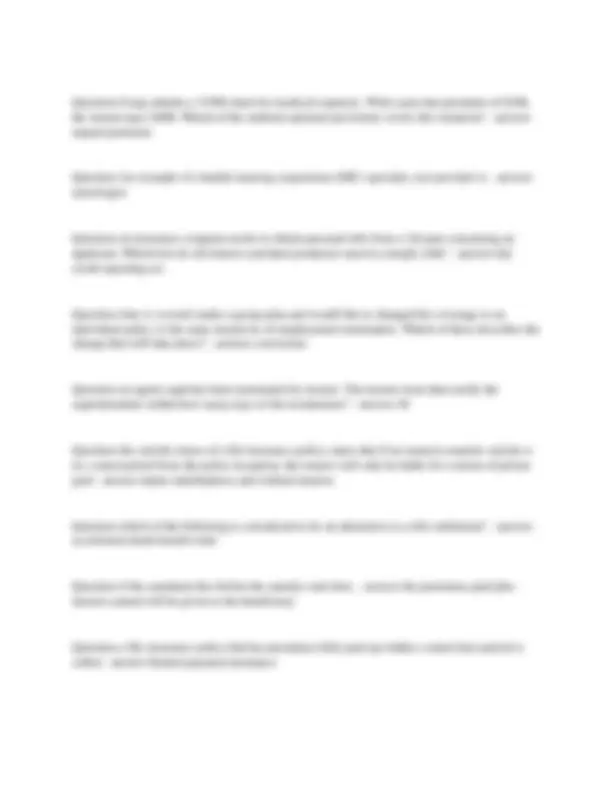
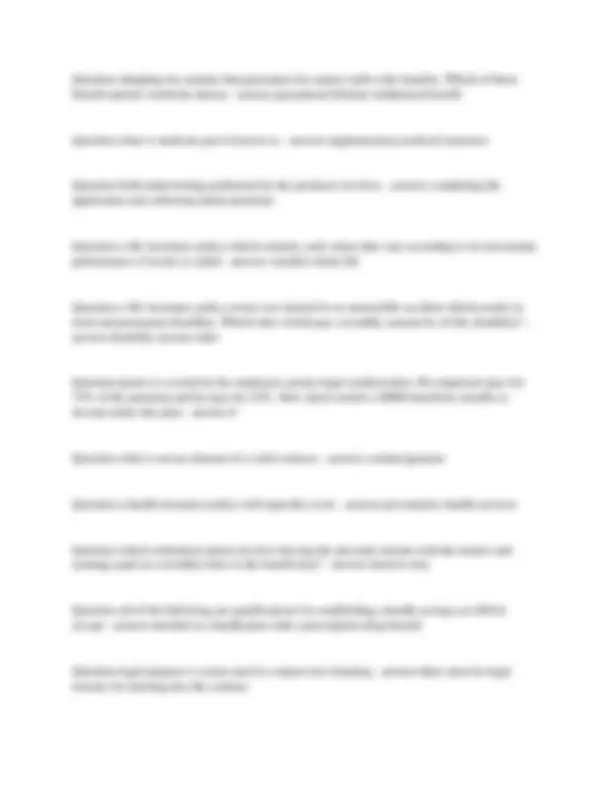
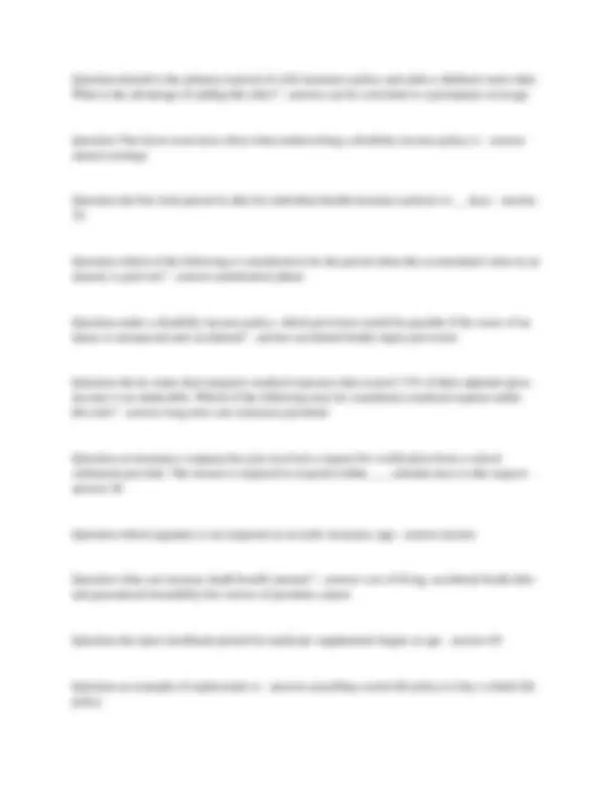
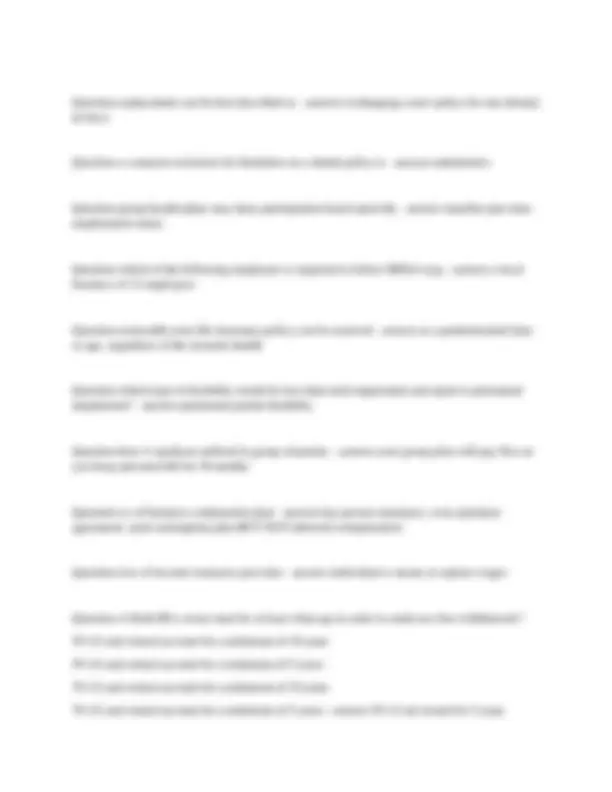
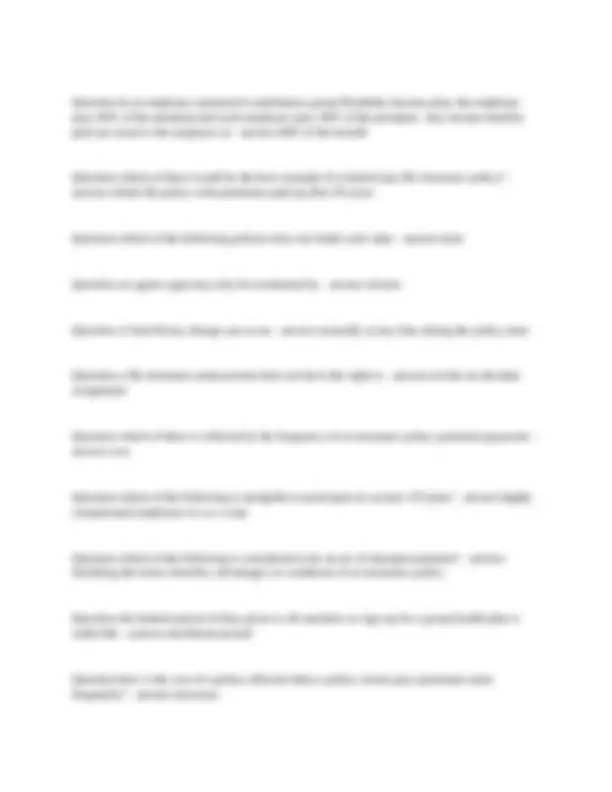

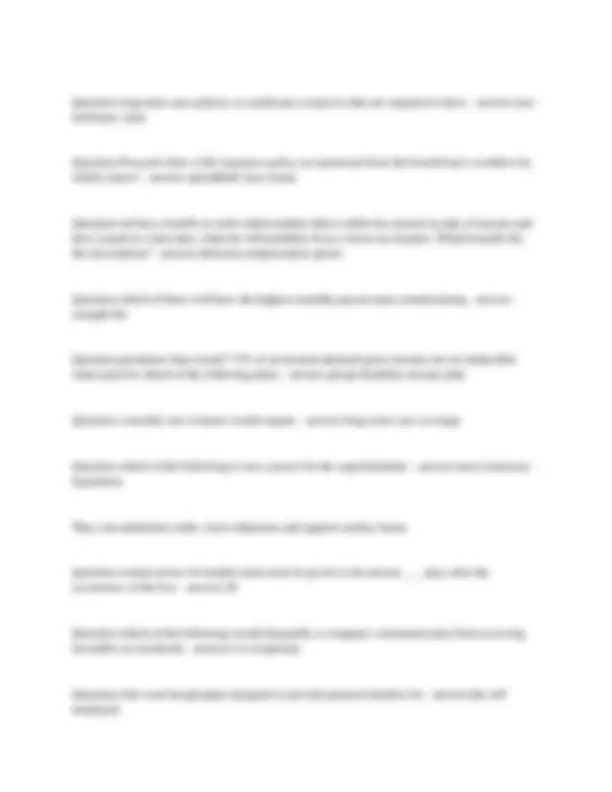
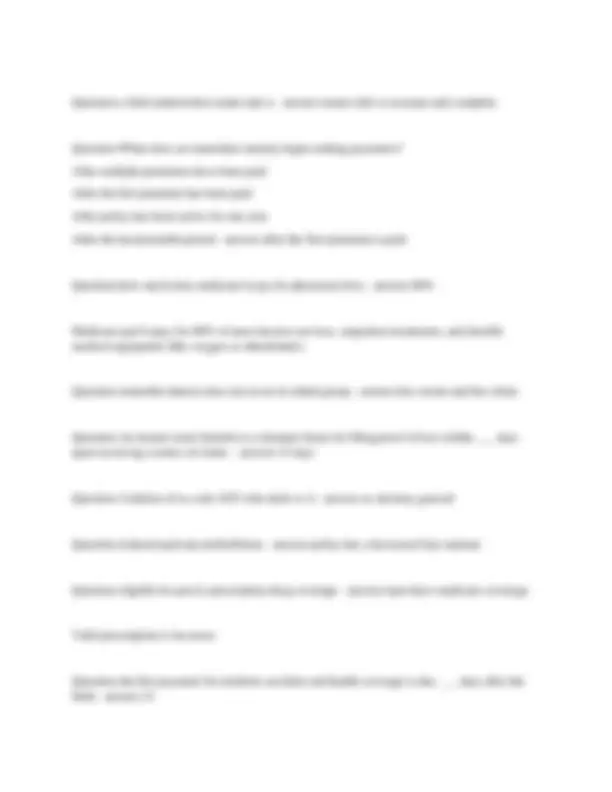
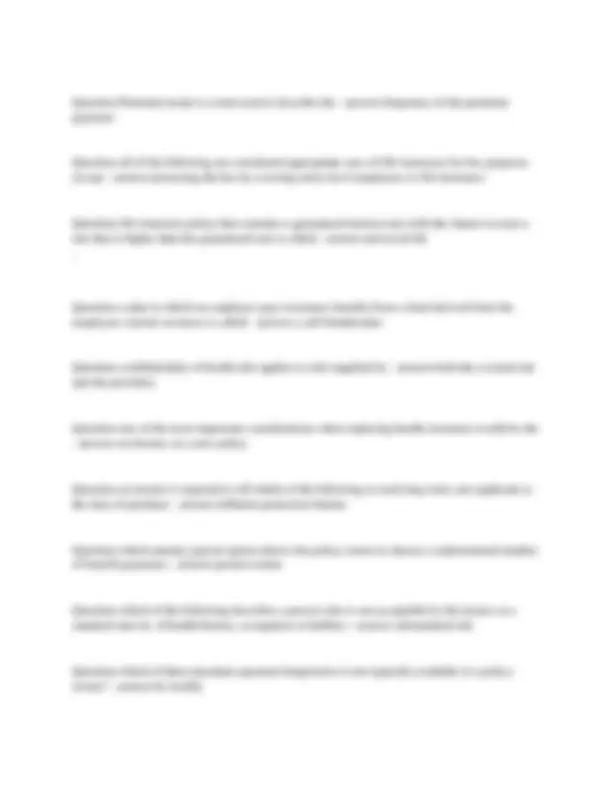
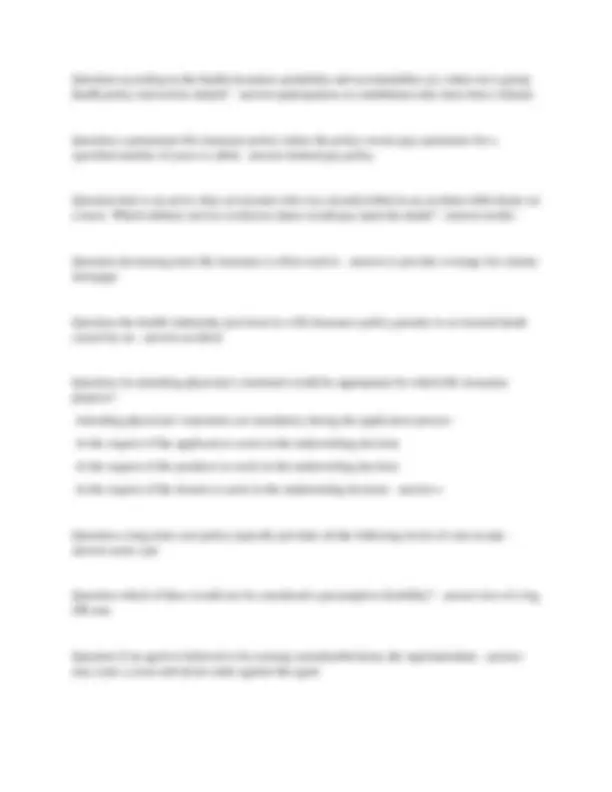
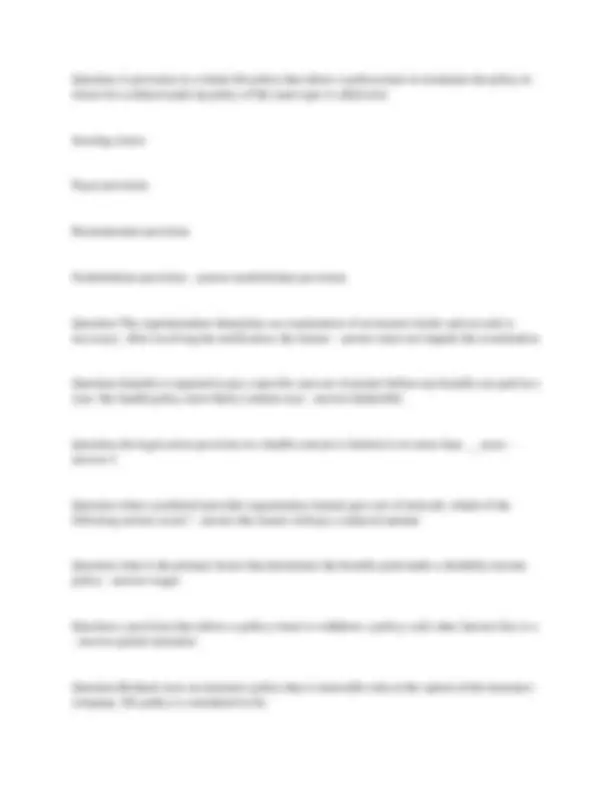
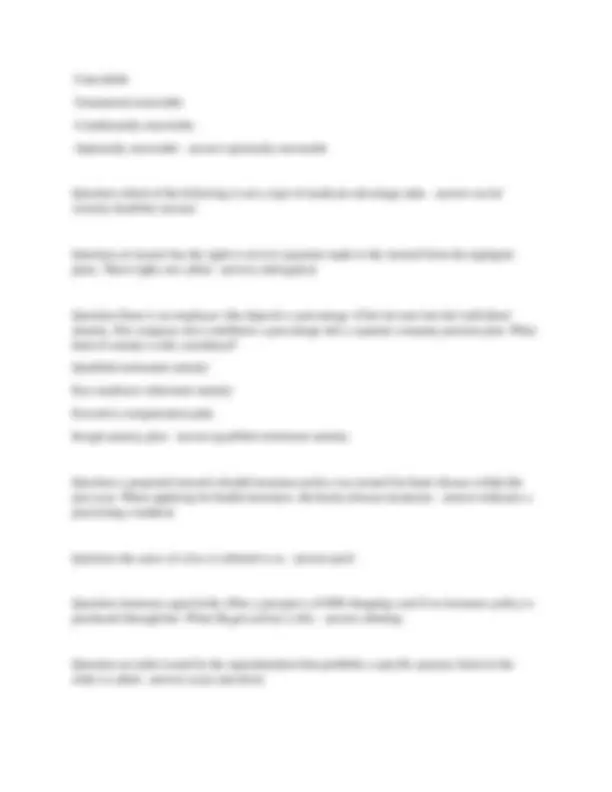
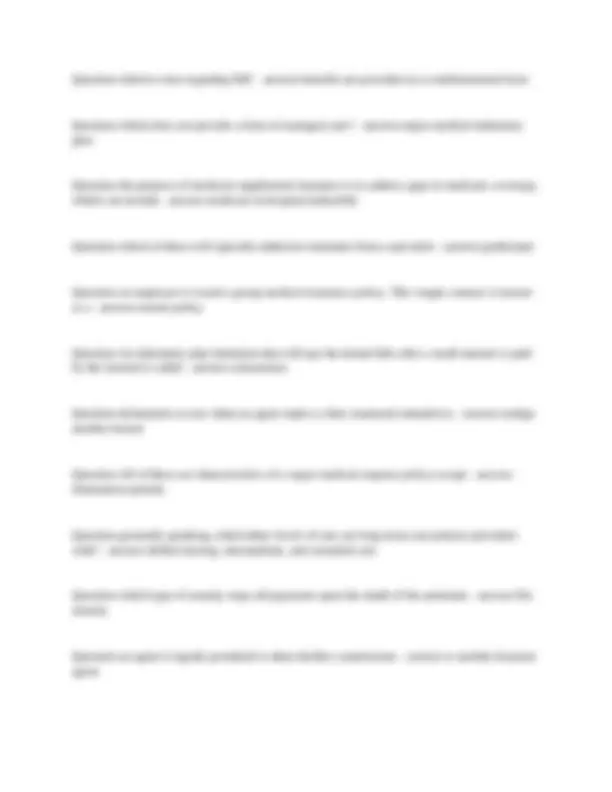

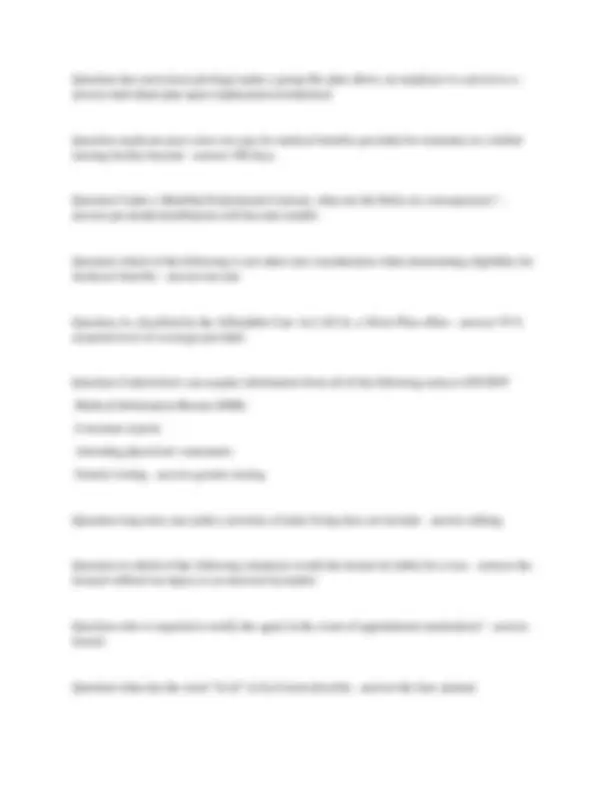
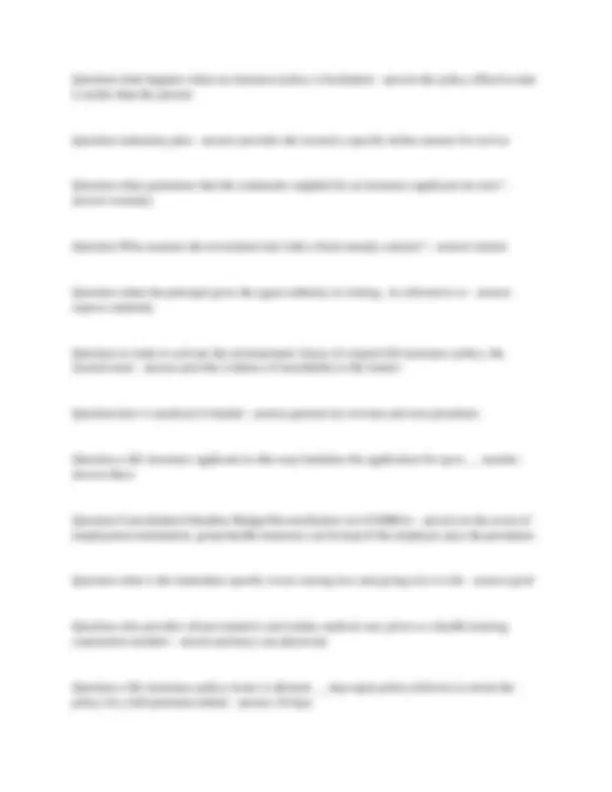
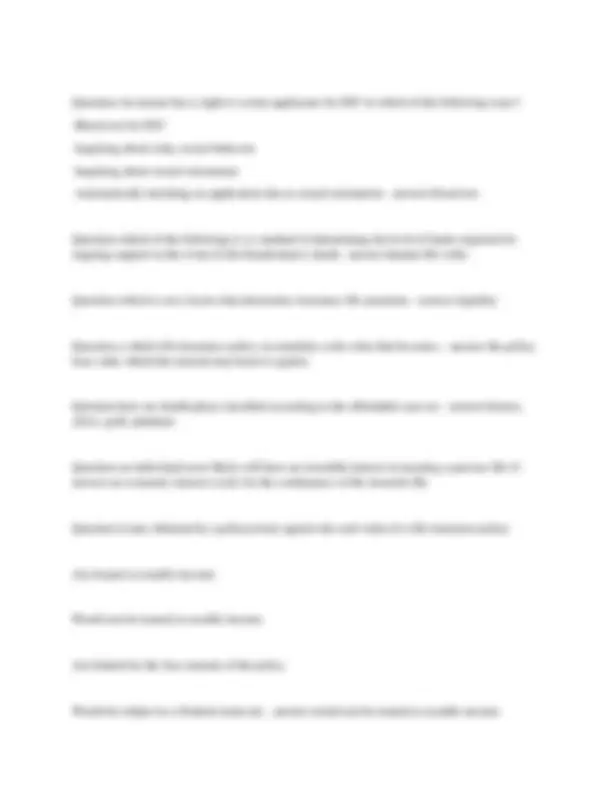
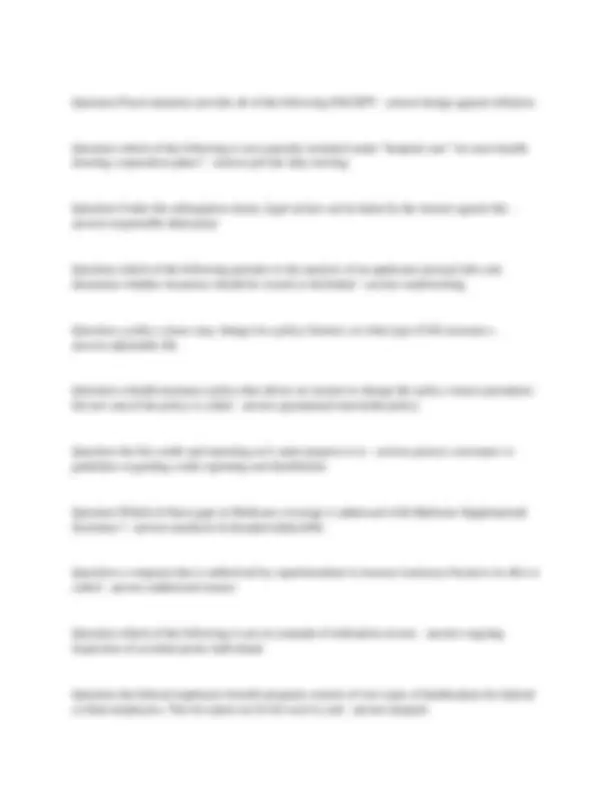
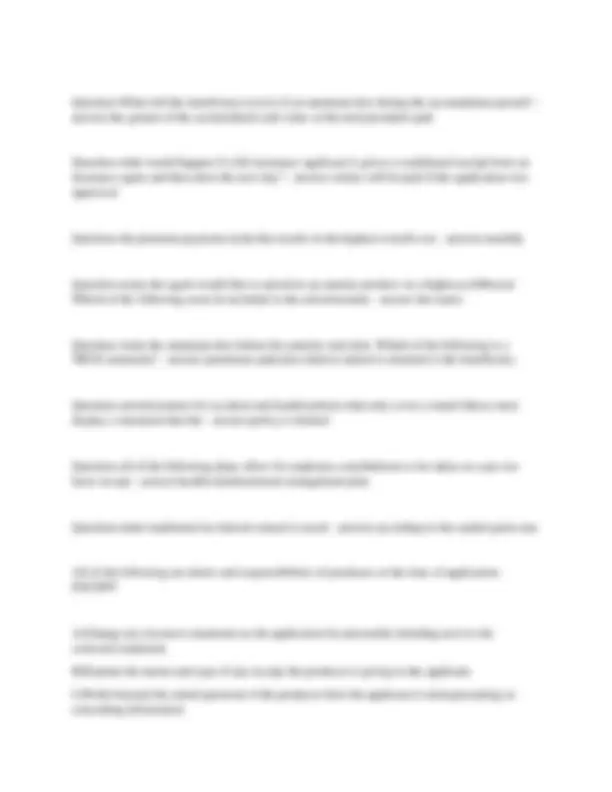
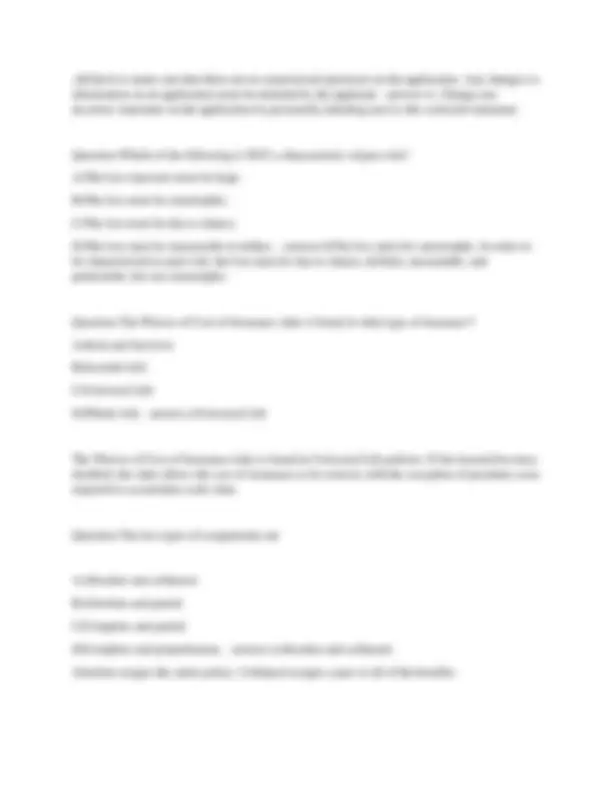
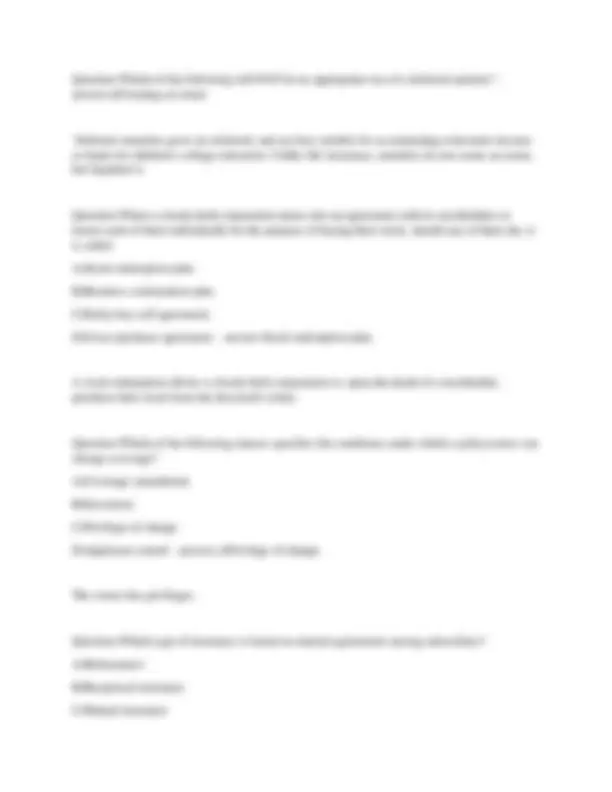
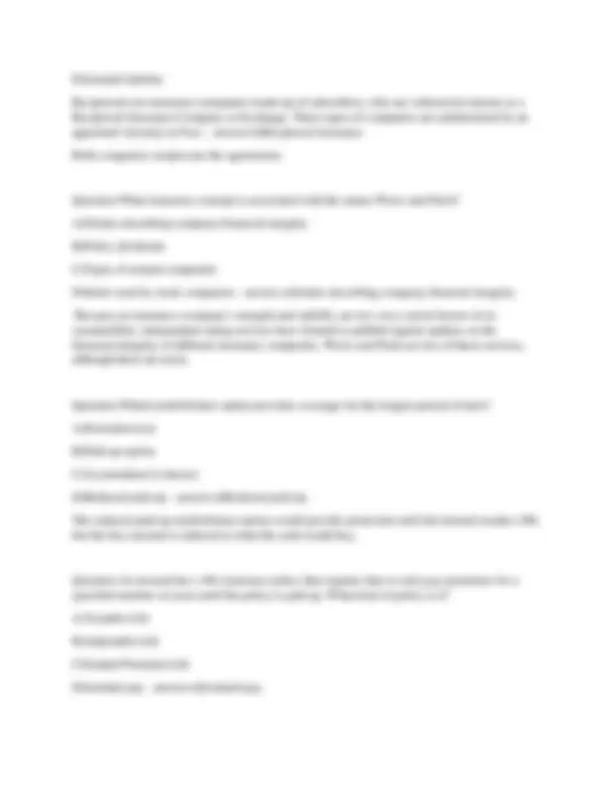
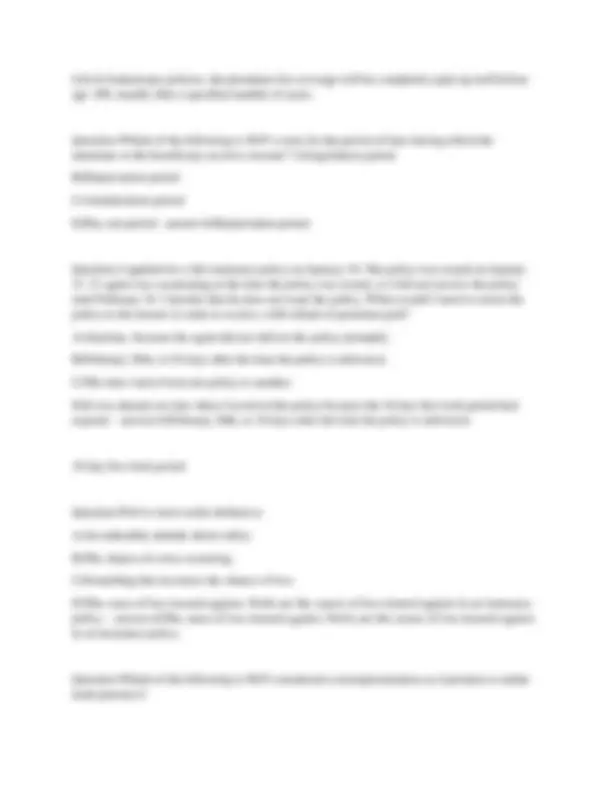
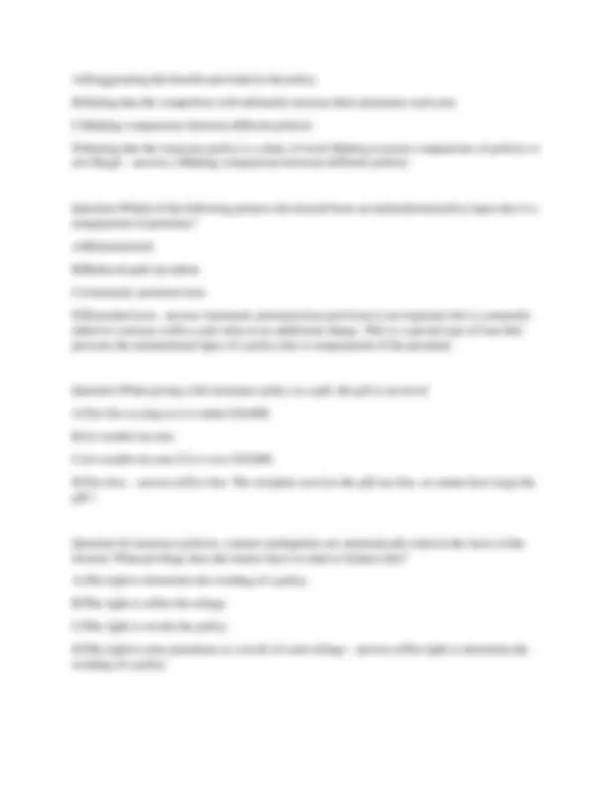
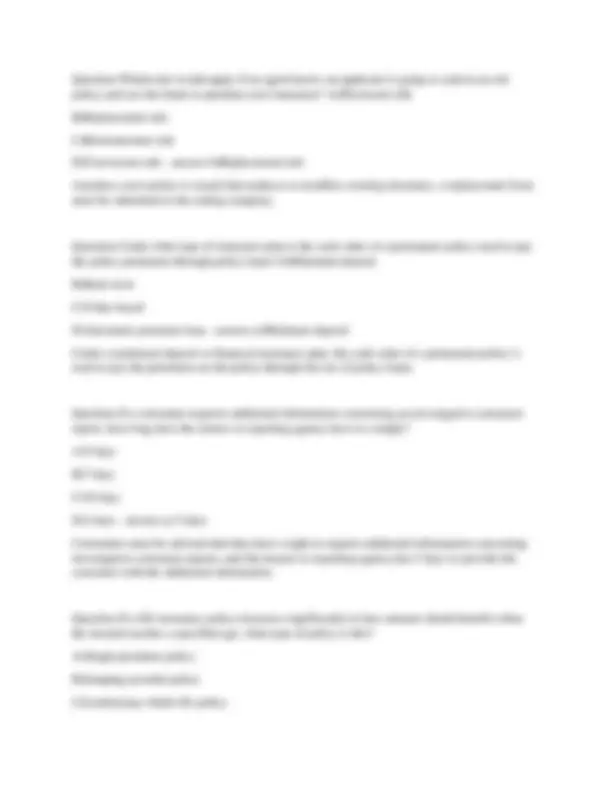
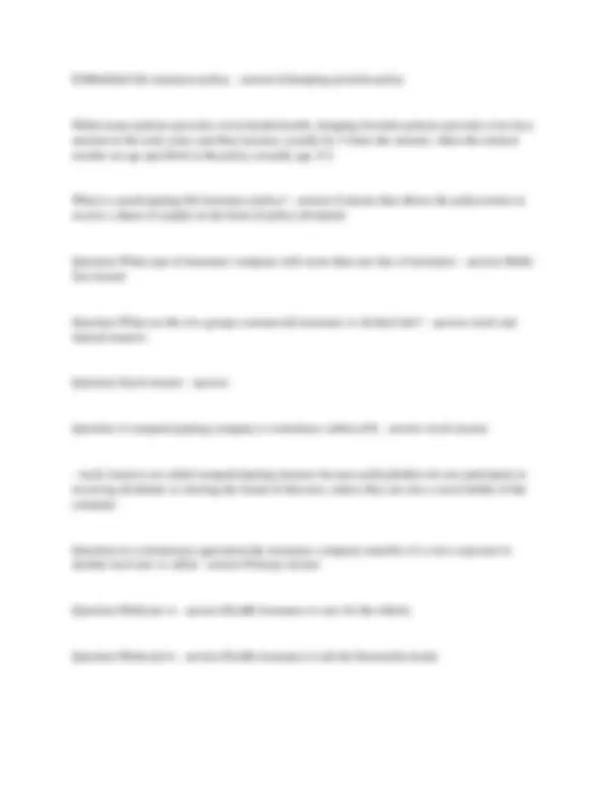
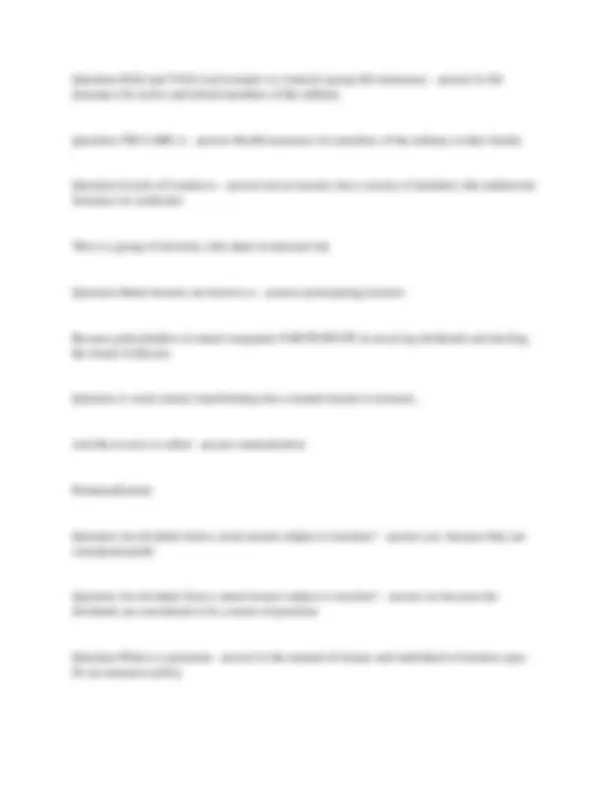
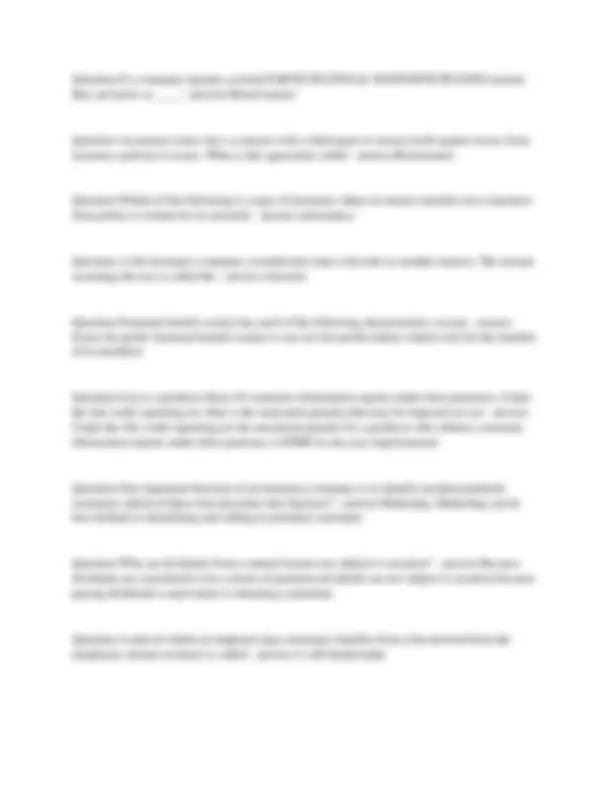
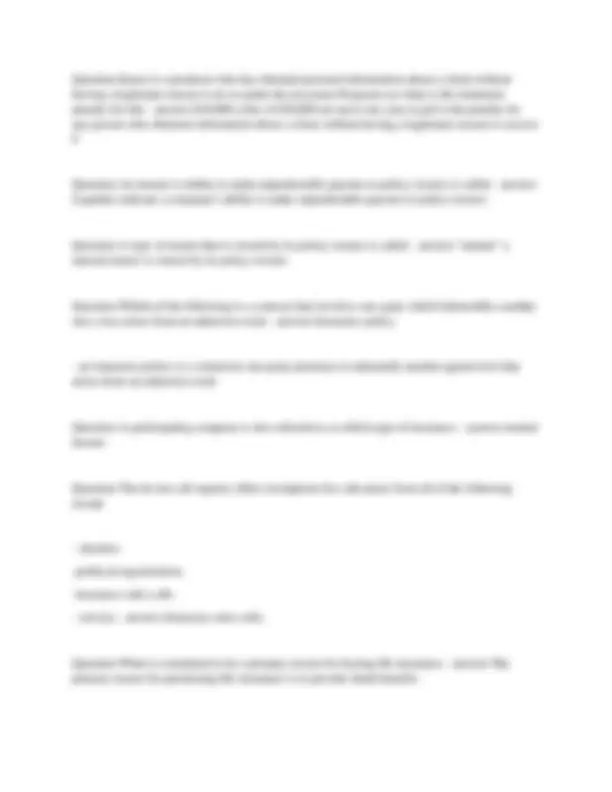
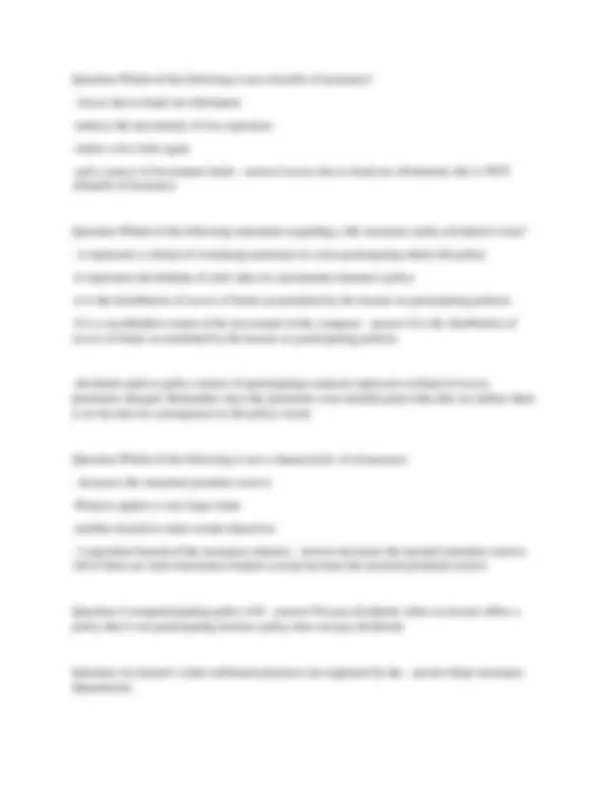
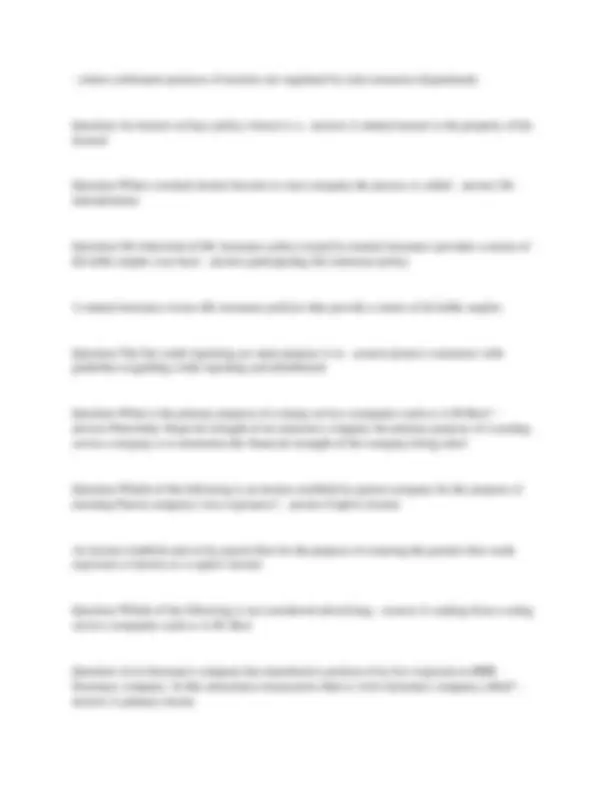
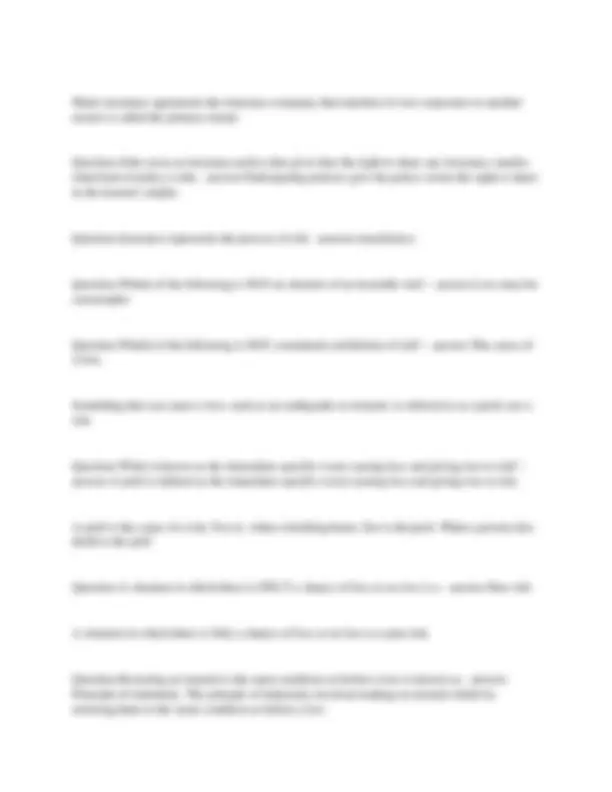
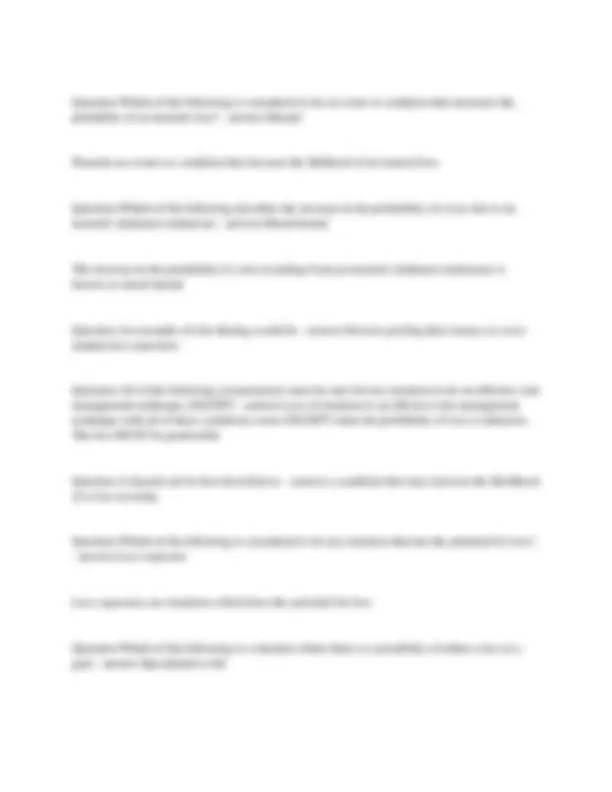

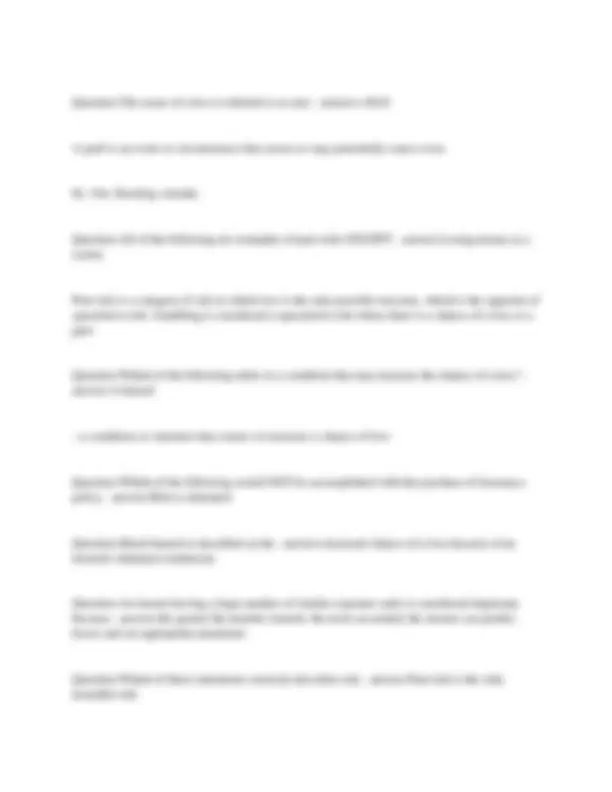
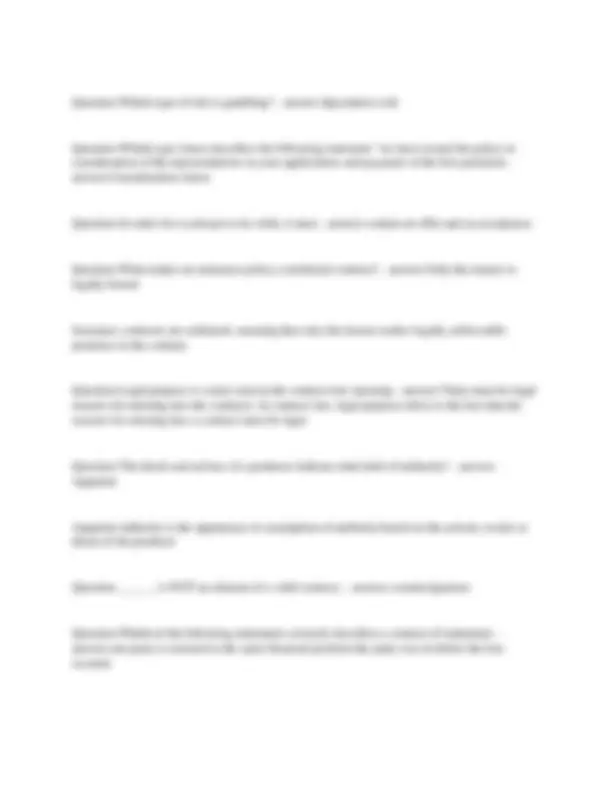
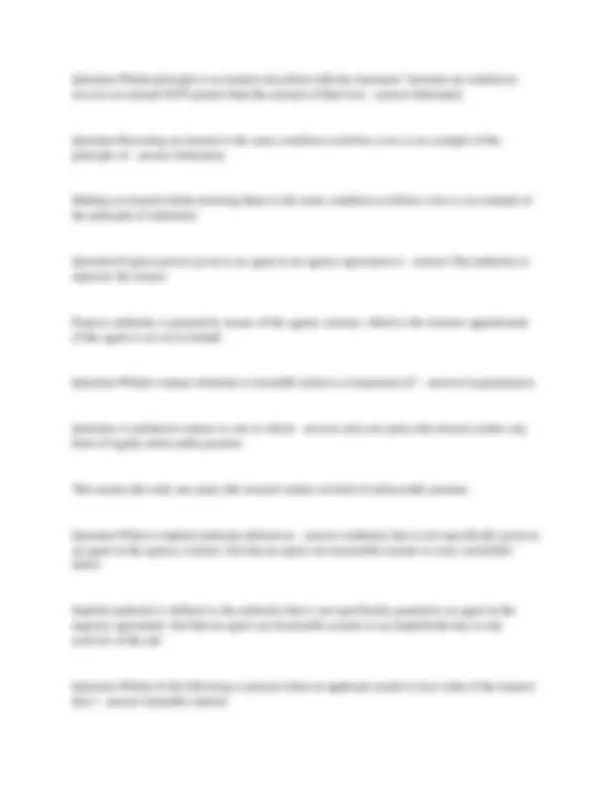
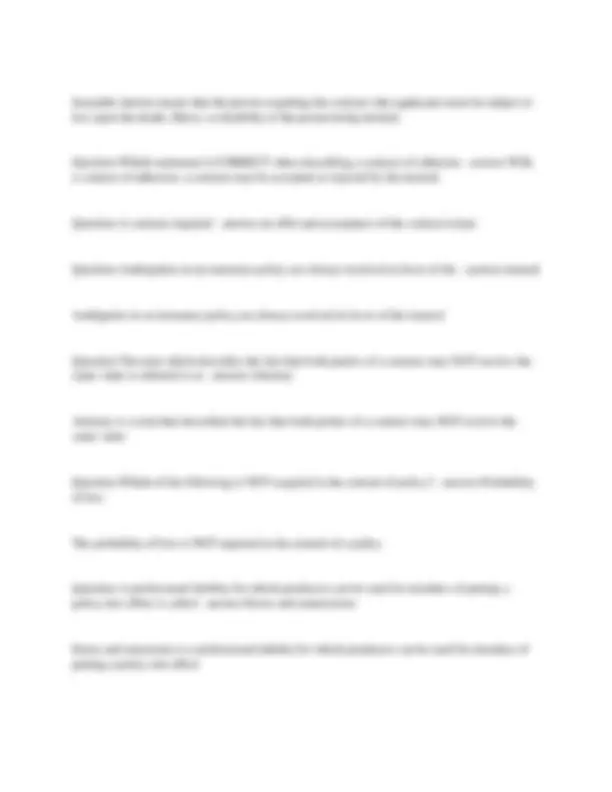
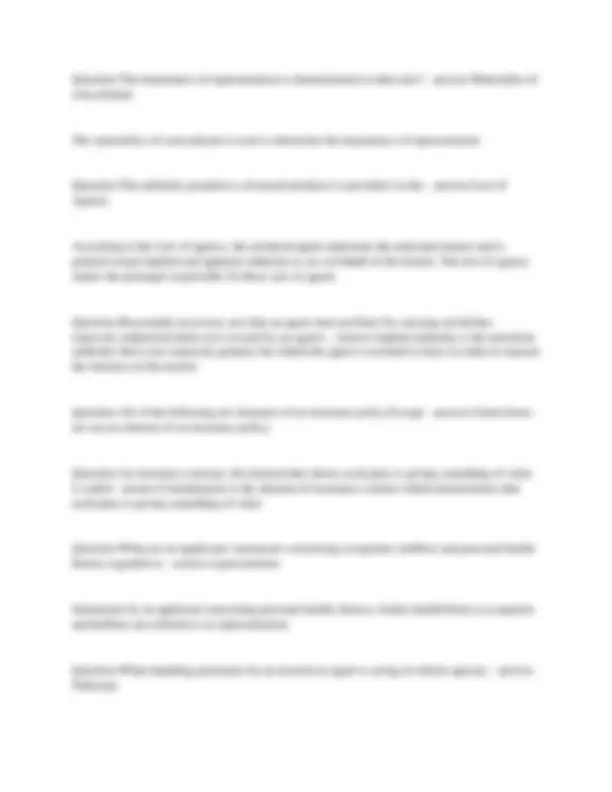
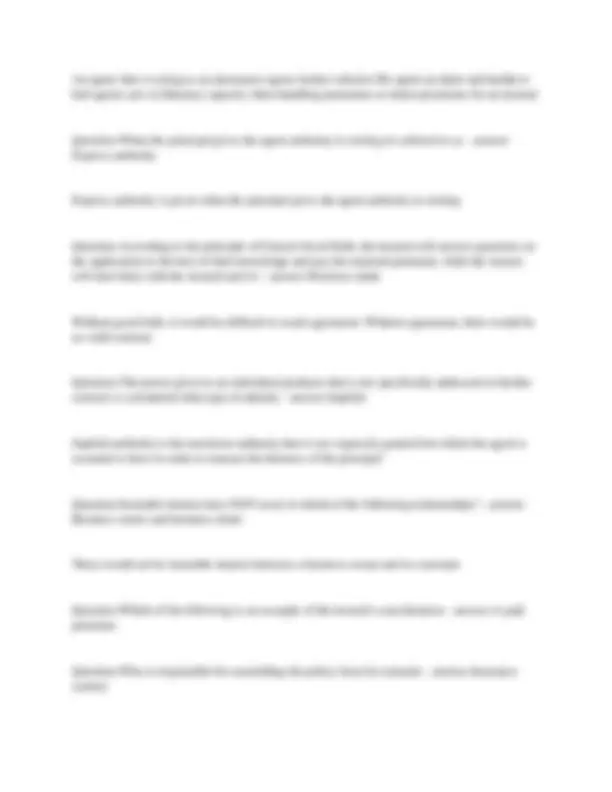
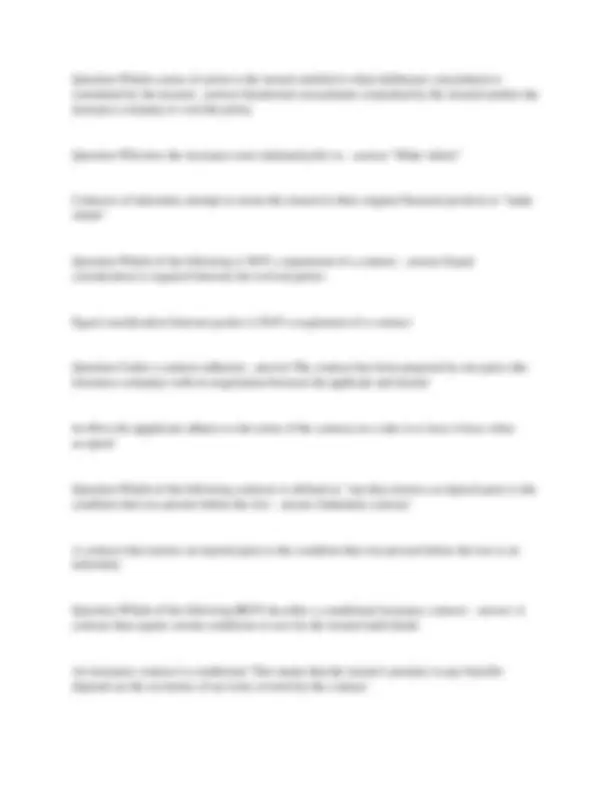
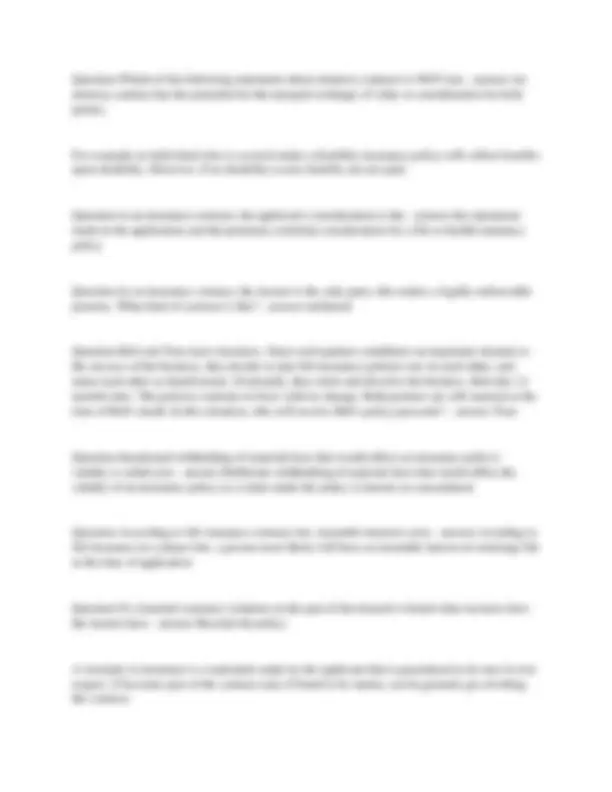
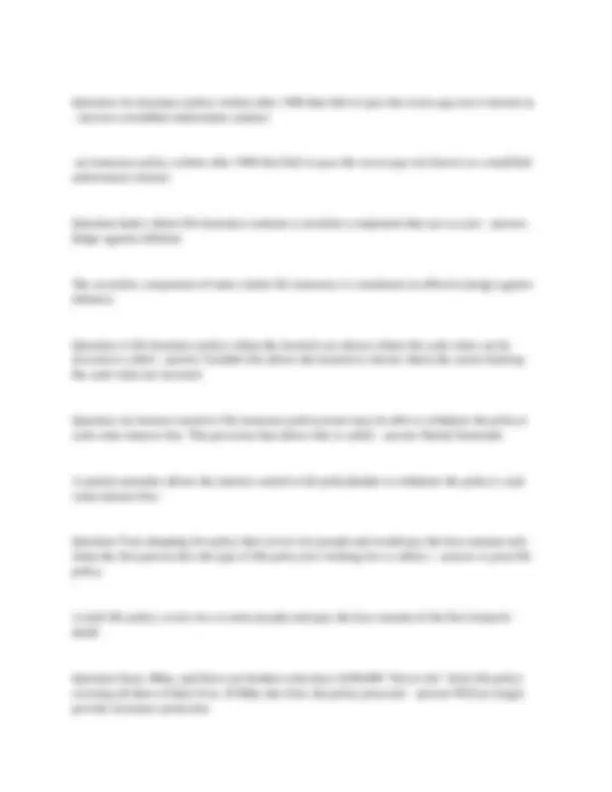
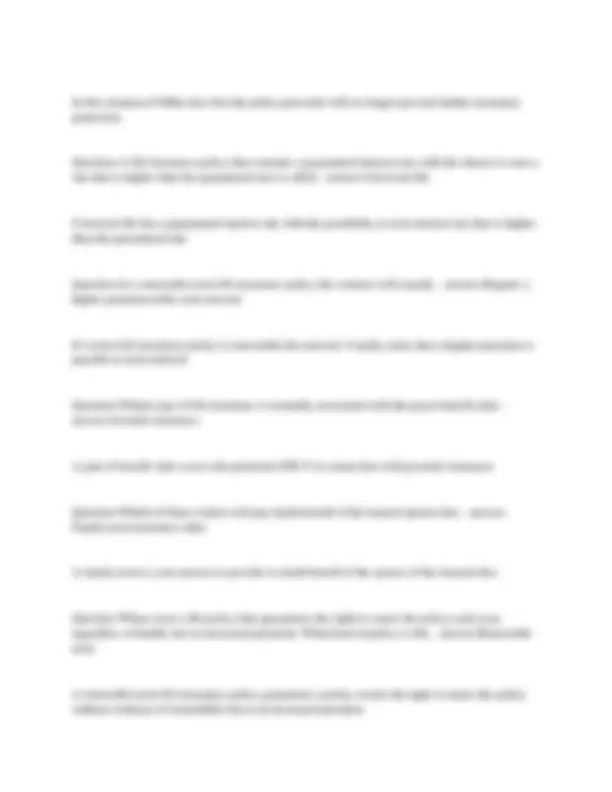
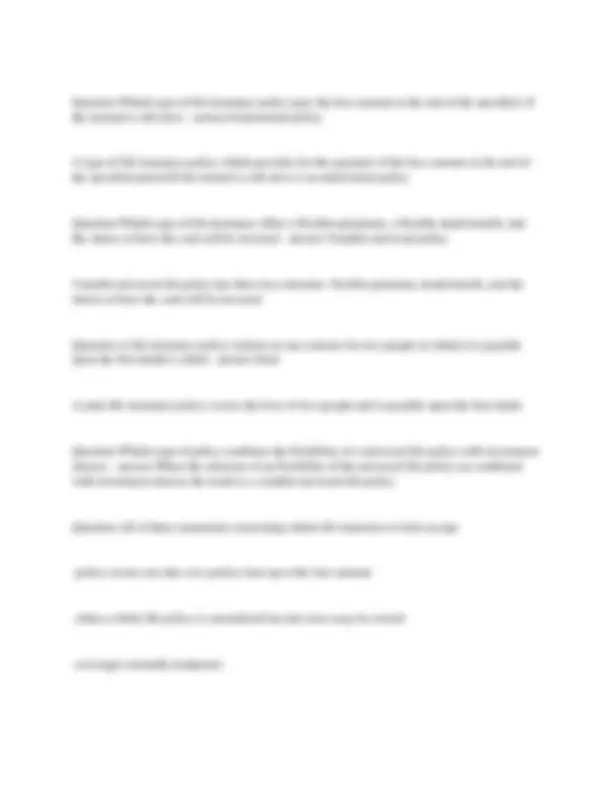
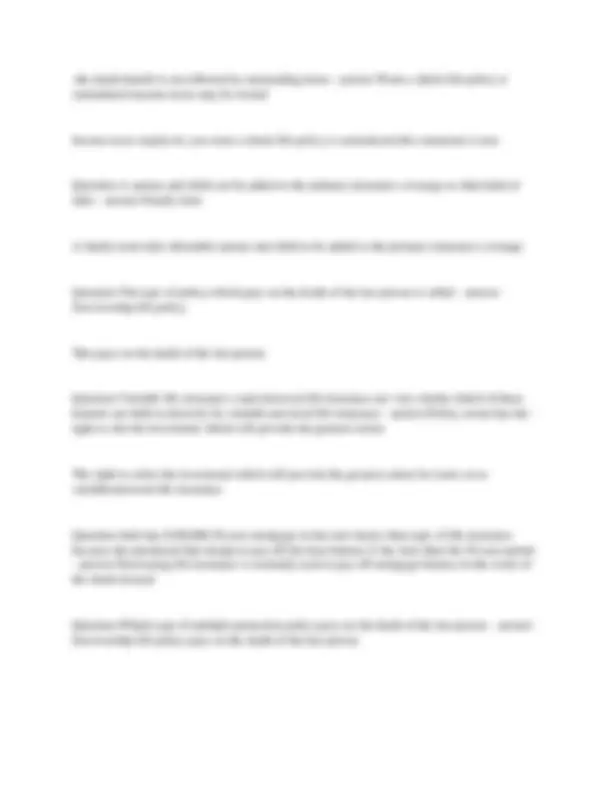
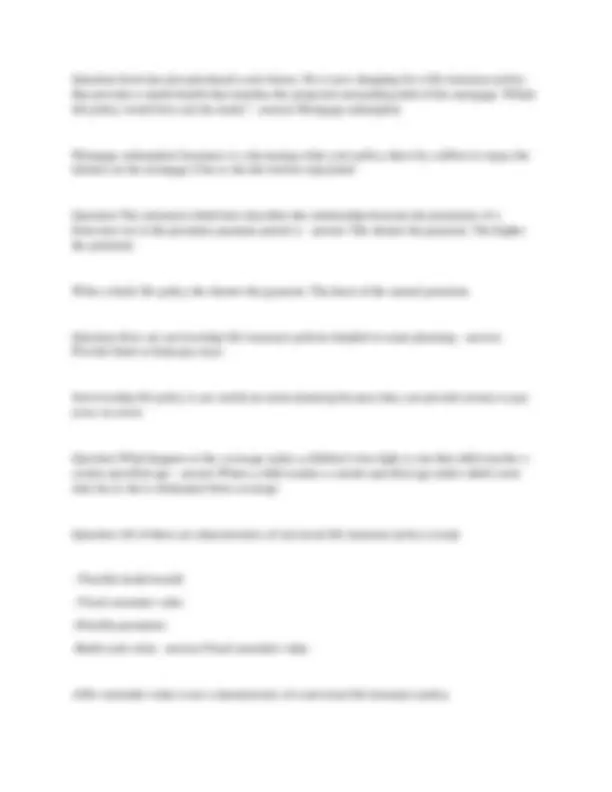
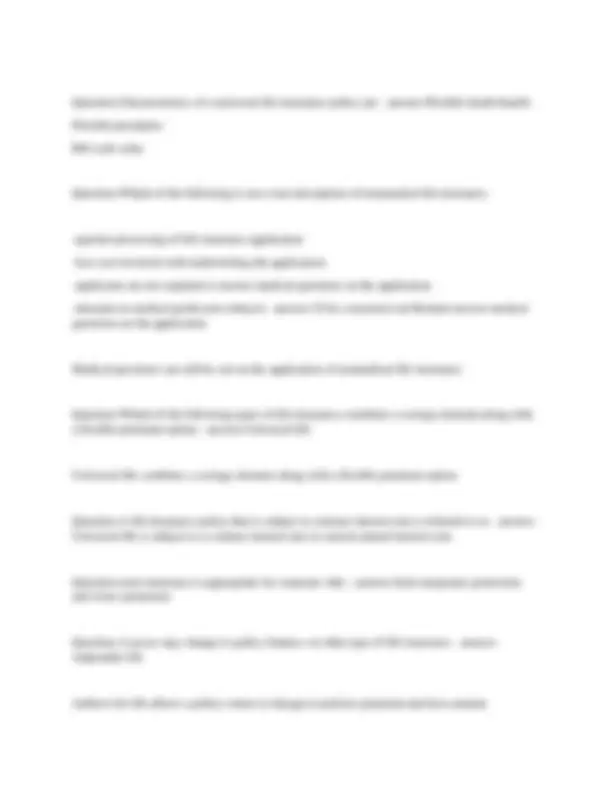
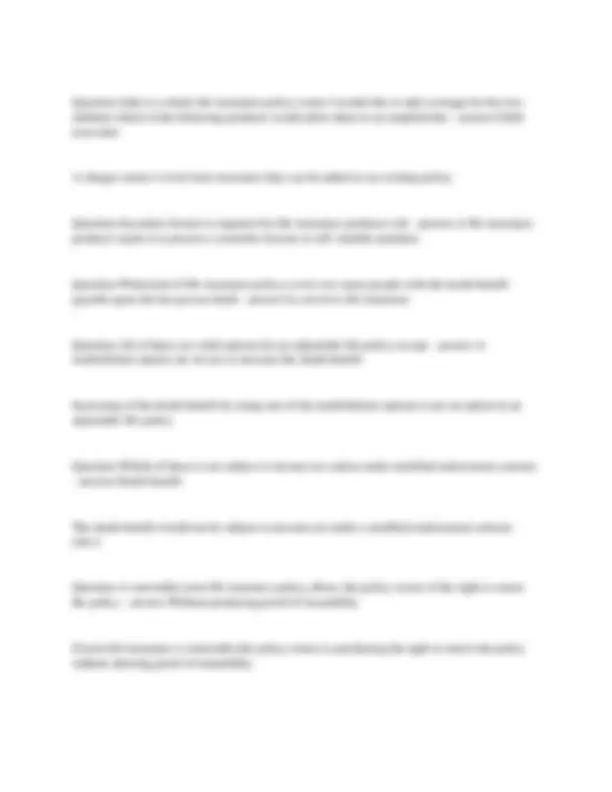
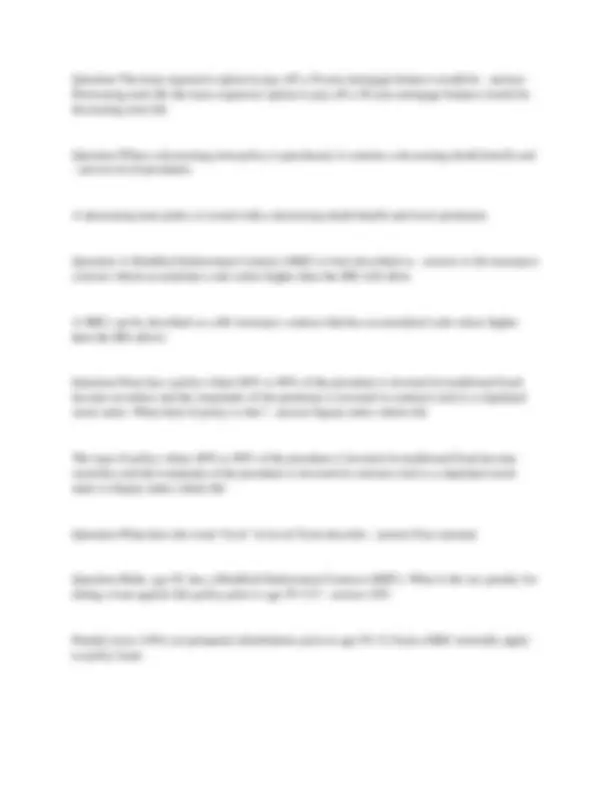
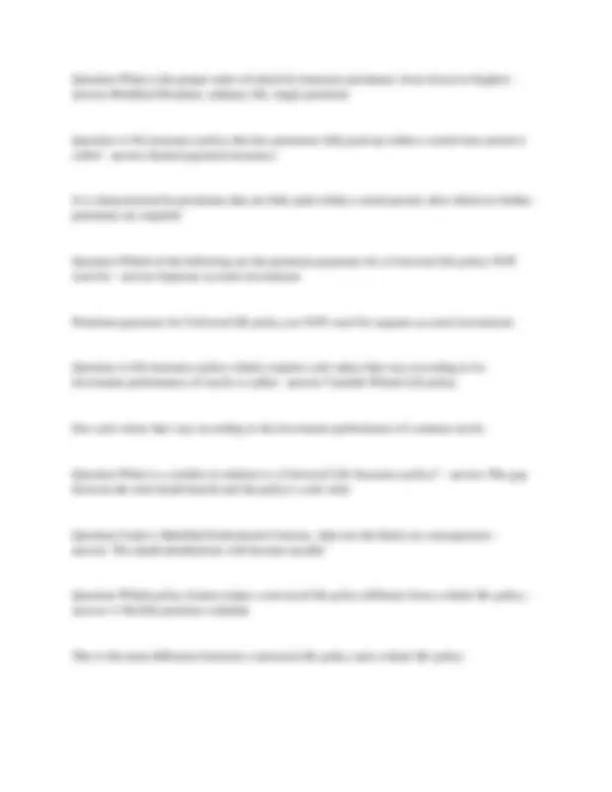
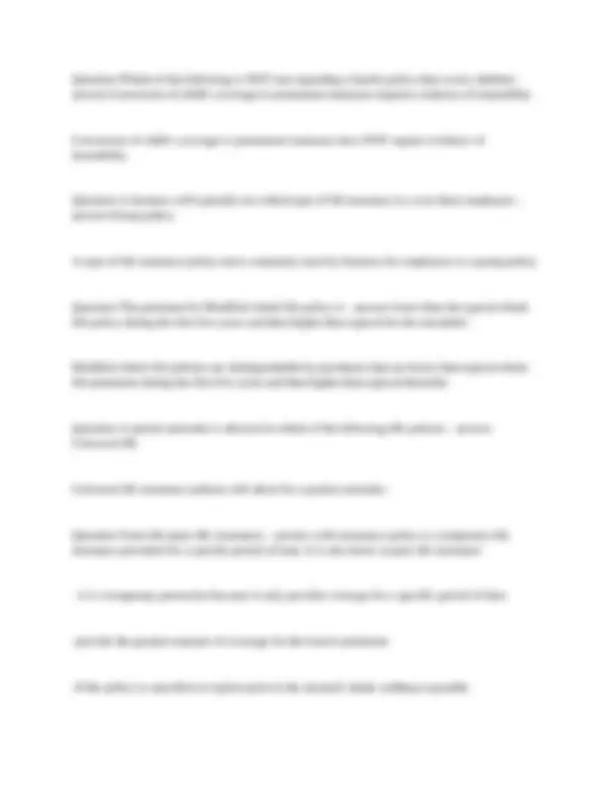



Study with the several resources on Docsity

Earn points by helping other students or get them with a premium plan


Prepare for your exams
Study with the several resources on Docsity

Earn points to download
Earn points by helping other students or get them with a premium plan
Community
Ask the community for help and clear up your study doubts
Discover the best universities in your country according to Docsity users
Free resources
Download our free guides on studying techniques, anxiety management strategies, and thesis advice from Docsity tutors
KENTUCKY LIFE INSURANCE NEWEST EXAM WITH 200 QUESTIONS AND CORRECT ANSWERS.pdf
Typology: Exams
1 / 77

This page cannot be seen from the preview
Don't miss anything!






































































Question-Contracts of Adhesion - answer-One-sided in regards to preparation (prepared by the insurer) Question-Contract of Utmost Good Faith - answer-Both parties bargain in good faith when forming and entering into the contract. The two parties rely upon the statements and promises of the other and assume no attempt to conceal or deceive has been made. Question-Executory Contract - answer-A contract that has not yet been fully performed. Elements of a Contract - answer-Competent parties, legal purpose, offer and acceptance, consideration Question-Waiver - answer-Voluntary giving up of a known right or privilege, can be express or implied Question-Estoppel - answer-A person is prohibited by virtue of his own past actions from claiming a right that would work to the detriment of another who relied on the past conduct Question-Aleatory Contract - answer-a contract where the values exchanged may not be equal but depend on an uncertain event Question-Mortality Rate - answer-Determined by dividing the average number of people who will die each year at each age by the entire population of people that age (1980 CSO table) Question-Functions of Life Insurance - answer-Create an immediate estate, requires no management or physical upkeep, paid in installments, can be used as collateral
Question-Final Expenses - answer-Medical and funeral expenses, outstanding debts Question-Total Needs Approach - answer-Totaling the amount required to pay for current and future expenses Question-Living Benefits of Life Insurance - answer-Loan value (can be used as collateral,) retirement benefits Question-Human Life Value - answer-The monetary value of an individual's life Question-Tax Advantages of Life Insurance - answer-Cash value earnings accumulate tax free, proceeds at death pass income tax free Question-4 Types of Life Insurance - answer-Permanent, Term, Industrial, Group Question-Permanent Life Insurance - answer-Accumulates cash value, insurance protection decreases as cash value increases Question-Term Life Insurance - answer-Accumulates no cash value, only provides death benefits Question-Whole Life Insurance - answer-A permanent policy for which you pay a specified premium each year for the rest of your life, cash value accumulates, endows at age 100 Question-Limited-Pay Life Policies - answer-Premiums are paid to a specified age or for a specified number of years and then stop. Protection remains for the rest of the insured's life. Question-Endowment Policies - answer-As of 1984, no policy can endow before age 95 because the CV and DB would be taxed
Question-Cash Value of ULP $0 - answer-Contract expires, policy goes into grace period, Question-Variable Life - answer-Securities based, whole life, NASD registration required, separate account holds assets, fluctuating death benefit but never below a guaranteed minimum (face amount of policy,) but no guaranteed CV, traditionally a fixed premium Question-Variable Universal Life - answer-Flexible premiums, choice of death benefits (A or B,) NASD registration required, separate account holds assets, fluctuating death benefit but never below a guaranteed minimum (face amount of policy,) but no guaranteed CV Question-Indeterminate Premium Policies - answer-Low current premium for first 3 years, premium is adjusted at end of 3 year duration based on investment return, mortality, and expenses, which can result in increase or decrease of premium (within a stated maximum) Question-Level Term Insurance - answer-Term insurance where the face value of policy remains the same from the date the policy is issued until the date the policy expires. Question-Decreasing Term - answer-A type of life insurance that features a level premium and a death benefit that decreases each year over the duration of the policy. Question-Convertible Term Insurance - answer-Term to Permanent, no requirement of proof of insurability, most people convert at attained age to avoid paying back premiums, time-limit varies by policy Question-Renewable Term - answer-Insurance which can, at the election of the policyowner, be renewed at the end of a term attained age without evidence of insurability within a time limit (commonly 30 days) Question-Interim Term - answer-Interim term coverage provides instantaneous coverage and is intended for people who plan on purchasing permanent life insurance coverage within one year, no proof of insurability, at attained age, built in time limit
Question-Family Income Policies - answer-Income is paid upon death of family breadwinner, combination of permanent and decreasing term coverage, children are added without additional premium and can convert at specified age without proof of insurability. Benefit duration lasts not starting from death but from when policy was purchased. Question-Family Maintenance Policies - answer-Combination of level term and permanent policies, income provided starting from insured's death Question-Jumping Juvenile Policy - answer-Purchased by parent, the child reaches age 21, coverage increases to five times the face amount, premiums remain the same and no evidence of insurability is required. Question-Industrial Life Insurance - answer-A type of insurance in which the policies are sold in small amounts and an agent of the company collects the premiums at the insured's home usually monthly or weekly (by home service companies) Question-Monthly Debit Ordinary Policy - answer-Higher premium amounts but paid monthly and collected at policyowner's home or by mail or bank account Question-Annuities - answer-A fixed sum of money paid to someone each year, typically for the rest of their life. Question-Annuitant - answer-The person who receives the payments from an annuity Question-Beneficiary - answer-Receives any survivor benefits payable under the annuity on the death of the annuitant Question-Fixed Annuity - answer-Specifies a fixed, guaranteed minimum rate of interest paid on the principle amount invested in the annuity, taxes are deferred during accumulation period Question-Variable Annuity - answer-Offers a variable, nonguaranteed rate of interest, taxes are deferred during accumulation period
Income amount and payment guarantee Loading for company expenses Question-Accumulation Units - answer-A variable annuity contract owner's interest in the separate account prior to annuitization, bought by the net purchase payment Question-Annuity Unit - answer-The number of annuity units denotes the share of the funds an annuitant will receive from a variable annuity account after the accumulation period ends and benefits begin. A formula is used to convert accumulation units to annuity units. Fixed number in amount, but payment varies. Question-Life Annuity (no refund) - answer-Provides a life income to the annuitant only while the annuitant remains alive Question-Refund Life Annuity - answer-Life annuity payout option in which the annuitant receives income for life and the beneficiary will receive the balance of premiums plus interest minus benefits already paid when the annuitant dies. Two types: cash refund and installment refund. Question-Life Annuity with Period Certain - answer-A Life Annuity that guarantees to provide income payments for a minimum period of time or life. Payments will continue to a beneficiary should the annuitant die during the specified period. Question-Joint Life and Survivorship Annuity - answer-An annuity under which payments Are made to two annuitants, with the Survivor continuing to receive payments After the first annuitant dies. Question-Joint Life Annuity - answer-Payments continue to two annuitants for only as long as both live. On the death of either one, payments stop.
Question-Tax-Sheltered Annuities - answer-Limited exclusively for employees of religious, charity, or educational groups.
Question-Common Disaster Provision - answer-Sometimes added to a policy and designed to provide an alternative beneficiary in the event that the insured as well as the original beneficiary dies as the result of a common accident. Question-Uniform Simultaneous Death Act - answer-It directs that in life insurance if the insured and the primary beneficiary die at the same time the policy benefits are payable as if the insured outlived the beneficiary. Question-Spendthrift Beneficiary - answer--Proceeds paid other than in a lump sum
Question-Reinstatement Clause - answer-Three conditions: policy owner must pay back all premiums plus interest, must show proof of insurability, less than 3 years must have elapsed Question-Privilege of Change Clause - answer-As a general rule, the insurance company will allow a change to a policy that calls for higher premium than the original, usually without medical examination. If lower premium, can require proof of insurability Question-Automatic Premium Loan Provision - answer-Authorizes insurer to automatically pay any premium in default at the end of the grace period and charge the amount so paid against the life insurance policy as a policy loan. Question-Policy Assignment - answer-The policyowner may assign a part of the policy or the entire policy. Question-Collateral/Partial/Conditional Assignment - answer-Assignment of part of the proceeds of an insurance policy to a bank as collateral to settle the loan balance that may exist at the insured's death. Question-Absolute, Voluntary, Complete Assignment - answer-Policy is given as a gift, policy owner has no means of recovering surrendered rights Question-Policy Exclusions - answer-WAR: policy won't pay if one dies due to a war. AVIATION: policy won't pay if one was to die in an aviation accident. HAZARDOUS OCCUPATIONS: Won't pay if death is due to a dangerous job or a risky hobby. COMMISSION OF A FELONY: policy won't pay if death happens during an illegal activity. Question-Riders - answer-Special policy provisions that provide benefits not found in the original contract, or that make adjustments to it. These special provisions are, in effect, attached to the policy. Question-Waiver of Premium - answer-Exempts insured from paying premiums while he is disabled during life of contract, must be specifically requested and added, subjects the company
Question-Viatical Settlement Contract - answer-An agreement under which the owner of a life insurance policy sells the policy to another person in exchange for a reduced percentage of the policy's face value, which is generally less than the expected death benefit under the policy. Question-Level Term Rider - answer-Must be attached to a permanent policy, must have a premium paying period at least equal to or greater than the term rider used in combination with it. Question-Decreasing Term Rider - answer-Can be added to get additional coverage on a whole life policy, normally in 3:1 or 5:1 ratios, additional premium is charged, many companies charge a premium for less than the duration of the rider, since it decreases, but still provide protection. Question-Increasing Term Rider - answer-Guarantees that in addition to the policy death proceeds, the cash values or the total amount of premiums paid in a permanent policy will also be paid/refunded to the beneficiary. Question-Factors for setting Premiums - answer-Expected death rate, profits from investment, cost of doing business, contribution to surplus Question-Net Premium - answer-Net of operating expenses, takes into account mortality rate and assumed interest Question-Gross Premium - answer-What the policy owner actually pays Question-Qualities of Premiums - answer-Company assumes they will be paid at the beginning of the year, the more frequent the premium payments, the higher annual outlay for coverage, the higher annual outlay makes up for interest earnings lost by not having the full amount invested, as well as the processing expenses for multiple payments Question-Insurance Reserves - answer-Policyholders' funds and investment returns that insurance companies are holding in anticipation of paying claims
Question-Net Payment Cost Index - answer-Cash value is omitted, does not assume the policy is surrendered at the end of the period Question-Sources of Policy Dividends - answer-Mortality, Assumed Interest, Operating expenses/loading Question-Accumulation at Interest Option - answer-A dividend or settlement option under which the policyholder allows his or her dividends or policy proceeds to accumulate interest with the company. Although the dividends or proceeds are not generally taxable, the interest earned is. Question-Paid-up Additions Option - answer-The dividend is used to purchase a small amount of paid-up whole life insurance, dependent on the amount of the dividend and the insured's attained age, proof of insurability isn't required, can be purchased with current and future dividends. Question-One-Year Term Dividend Option - answer-Dividend is used to buy term coverage of one year's duration. Question-Cash Surrender Value Option - answer-The policyholder receives the policy's cash value or cash accumulation as a lump sum. Any outstanding policy loans are deducted from the cash payout. Question-Reduced Paid-Up Insurance Option - answer-Policyowner uses the CV of a present policy to purchase a single premium insurance policy at attained age for reduced face amount. Face amount remains constant, no further premium payments, attained age, no expense loading, same policy minus any attached riders. Question-Extended Term Option - answer-Uses the policy's cash value to purchase a term insurance policy in an amount equal to the original policy's face value for as long a period as the cash value will purchase. Different type of policy, same amount, fully paid up, any outstanding loans are deducted from cash value AND face amount Question-Advantages of settlement options - answer-insurer invests the money, money is safe with insurance company, guaranteed interest earnings
Question-Proposed Insured - answer-One whose life is being insured Question-Applicant - answer-Party making the application to the insurance company, may or may not be the proposed insured Question-Application - answer-A formal request for an insurance policy that implies that the provided information is true to the best of the applicant's knowledge. Question-Correcting an Application - answer-Must initial any changes, have written approval, for both agent or company changes Question-Warranty - answer-a statement that becomes part of the insurance contract and is guaranteed by the maker to be true in all respects Question-Fraud - answer-intentional misrepresentation of an existing, important (material) fact with intent to gain advantage and relied upon by a second party that suffers a loss Question-Concealment - answer-Withholding of facts that should be given to the insurance company because they would most certainly affect the company's decision of issuing a policy Question-Conditional Receipt - answer-Agent can't guarantee the policy will be issued, serves as a receipt for the first full premium and a statement that the policy will be issued subject to the approval of the company. If insured dies before policy is issued, proceeds are only issued if they would have been if the insured had been living Question-Binding Receipt - answer-Provides coverage as soon as premium is received (before approval) Question-Temporary Insurance Agreement - answer-Also referred to as the binding receipt or unconditional receipt. Coverage begins on the date of the application regardless of whether or not the applicant is insurable. Coverage is issued for a short period of time, such as 30 to 60 days.
Question-Policy Effective Date - answer-Provides full protection from that date, fixes the date from which the contestable period runs Question-Backdating - answer-The practice of making a policy effective at an earlier date than the present. Permits the insurer to be rated a year younger, premium payment dates correspond to the income pattern of the policyholder, enables the purchase of a policy issues to younger customers Question-Peril - answer-The cause of loss Question-Methods of Risk Management - answer-Avoid, reduce, retain, transfer Question-Adverse Selection - answer-People who are most likely to experience loss are more likely to seek insurance than those who are not Question-Hazard - answer-Anything that increases the chance of loss Question-Factors used to determine Insurability - answer-Age, occupation, physical condition, medical history, moral fitness, financial condition, place of residence, lifestyle Question-Medical Information Bureau - answer-Nonprofit organization supported by several insurance companies, houses all information it receives about a proposed insurer from its member companies. Impairments are stored, company actions are not Question-Classes of Hazard - answer-Present physical condition/medical history, occupation, moral fitness, avocation hazard Question-Rated up Policies - answer-Policies on special class risks that often charge a higher- than-standard premium when policy is first issued Question-Insurable Interest - answer-applicant must have an interest in insuring that the other person remains alive
Question-Noncontributory Plan - answer-Employer pays the entire premium, must include all eligible employees determined by the class the employer selects eligibility based on length of service and salary. If no eligibility requirements, must be a full time employee, actively at work, and has served any required probationary period. Question-Eligibility Period - answer-Specified number of days after the eligibility period in which the employee is eligible to obtain nonmedical coverage under the plan Question-Advantages of Group Life - answer-Lower premiums, not required to furnish proof of insurability, employer pays all or part of the premium Question-Disadvantages of Group Life - answer-Only one method of receiving policy proceeds (lump sum payment,) group policies usually provide no cash value build up Question-Converting from Group to Permanent Insurance - answer-No proof of insurability, conversion must be to permanent policy, must be applied for within one month of termination, premiums based on attained age Question-Spouses and Group Coverage - answer-Same percentage as employees, 100% of spouses must be included for noncontributory, 75% must be included for contributory Question-Three Categories of Business - answer-Sole proprietorship, partnerships, corporations Question-Disposition - answer-Selling the business interest at a reasonable price, keeping the business interest in the family, liquidating the business because it is not longer practical to operate it Question-Buy-Sell Agreement - answer-Agreement that a deceased business owner's interest will be sold and purchased at a predetermined price or at a price according to a predetermined formula, must include a funding provision Question-Entity Purchase Buy-Sell - answer-Used when the partnership buys the policies on the partners
Question-Cross-Purchase Buy-Sell Agreement - answer-An arrangement between individuals who agree to purchase the business interest of a deceased owner Question-Section 303 Redemption - answer-Stock may be redeemed from an estate in an amount equal to the total amount of estate/inheritance taxes, admin costs, and funeral expenses, only considered a partial redemption Question-Key Employee Insurance - answer-Pays a benefit to the business when a key employee becomes disabled by helping pay for a replacement, train a new employee, or replace loss of revenue due to the disabled employee's lack of ability to work. Question-Deferred Compensation - answer-Plan that provides income to employees at some future time as compensation for work performed now (usually provided at retirement) Question-Section 457 Deferred Compensation Plan - answer-Employees of state and local governments and certain nonprofit organizations can set aside part of their salaries and put it into life insurance or annuities Question-Split-Dollar Insurance - answer-Employer and employee each pay part of a premium for life insurance on the employee's life, makes additional insurance coverage cheaper Question-Qualified Retirement Plan - answer-A retirement savings plan approved by the Internal Revenue Service that provides individuals with a tax benefit: tax deductible to the business, not currently taxable to the employee, accumulates on a tax-differed basis, taxed at retirement under advantageous rules Question-Defined Benefit Plan - answer-Plan that promises employee a retirement benefit amount based on a formula, contributions fund the promised benefits Question-Defined Contribution - answer-a pension benefit based on the amount that has accumulated in the account, including contributions plus any gains or losses from investments, expenses, or forfeitures; a savings account with certain tax advantages